Best Things to do in Menorca, Spain (Walks, History, Beaches & More!)
The beautiful island of Menorca is a slow-paced paradise in the Mediterranean Sea. A haven for culture and history, the northernmost of the Balearic Islands boasts white sand beaches, verdant national parks, lively towns and cities, and delicious food and drink.
A favourite holiday destination for families and couples, there’s much to see and do, from hiking picturesque coastal trails and listening to live music in caves to visiting open-air archaeological museums or wine tasting in a local vineyard.
Outdoor enthusiasts will adore the variety of sporting activities on offer, ranging from scuba diving, paddle boarding and sailing, to horse riding and cycling.
If you’re seeking a laid-back destination in Europe for your next holiday and looking for what to do in Menorca, look no further, here is our insider’s guide, so that you can gain the most from your trip to this unspoilt Spanish Island.
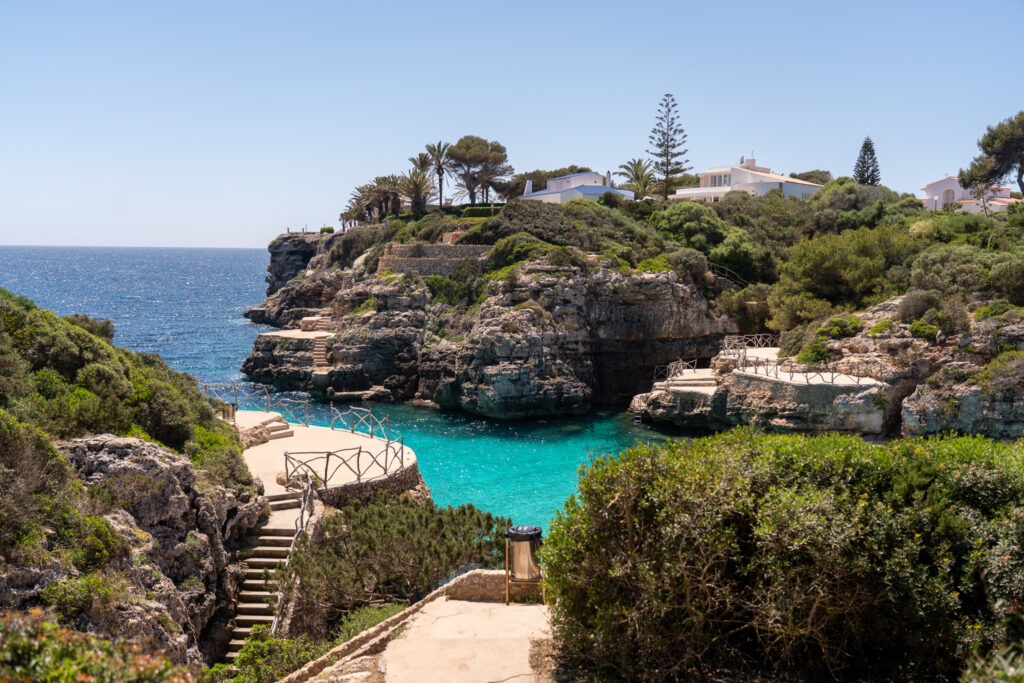
Best Menorca Attractions and Activities
Menorca is home to twin cities, which are located on either side of the island, the capital, Mahon in the east, and historic Ciutadella in the west. They are wonderful places to begin to delve into the rich heritage and culture of the island.
Tourists can follow the coastal trails of Cami de Cavalls to picturesque lighthouses or climb the island’s only mountain, Monte Toro (El Toro) for spectacular 360-degree views.
Relax on the secluded beaches of Cala Macarelleta or Cala Algaiarens, or cycle to pretty fishing villages such as Binibeca Vell with its whitewashed houses and handicraft shops.
Wherever you decide to stay on your holiday, here are our top things to do in Menorca, so you don’t miss out on a single thing.
EXPLORE THE CITY OF CIUTADELLA DE MENORCA
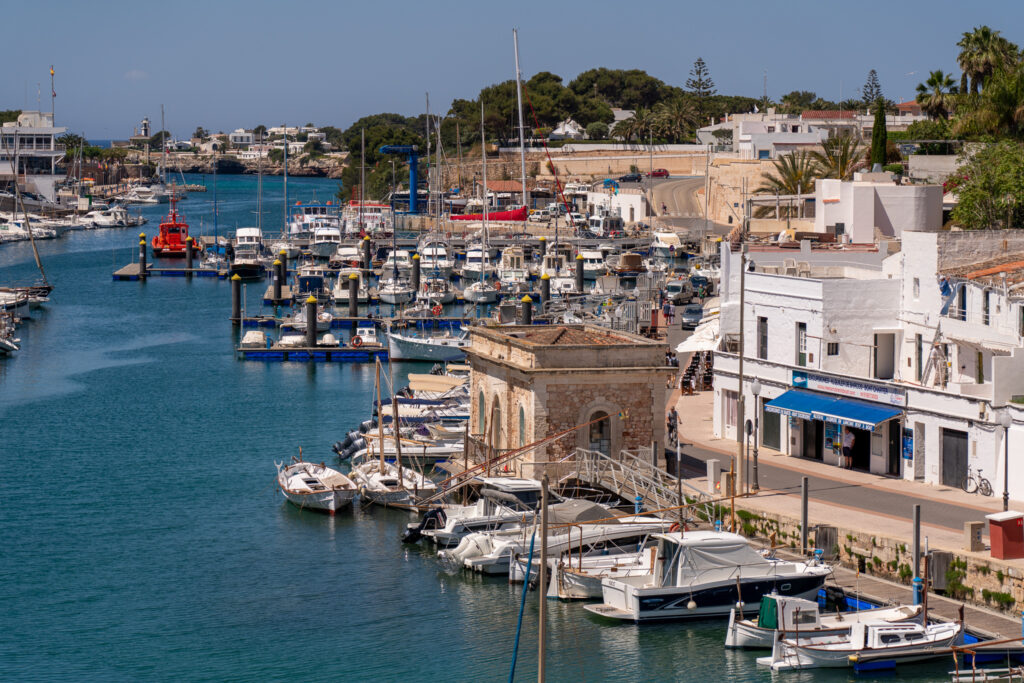
Ciutadella sits on the western shores of Menorca, an appealing city known to locals as vella i bella – the old and beautiful. It has a charming historic quarter to explore with winding cobbled streets and a small harbour where you can dine alfresco and watch fishermen bring in their catch of the day.
One of the busiest squares is the palm-fringed Plaça d’es Born, home to an obelisk, gardens and a 13th-century cathedral. Wander a little further and Palau Salort, a stately neoclassical palace and Teatre des Born, a historic theatre come into view.
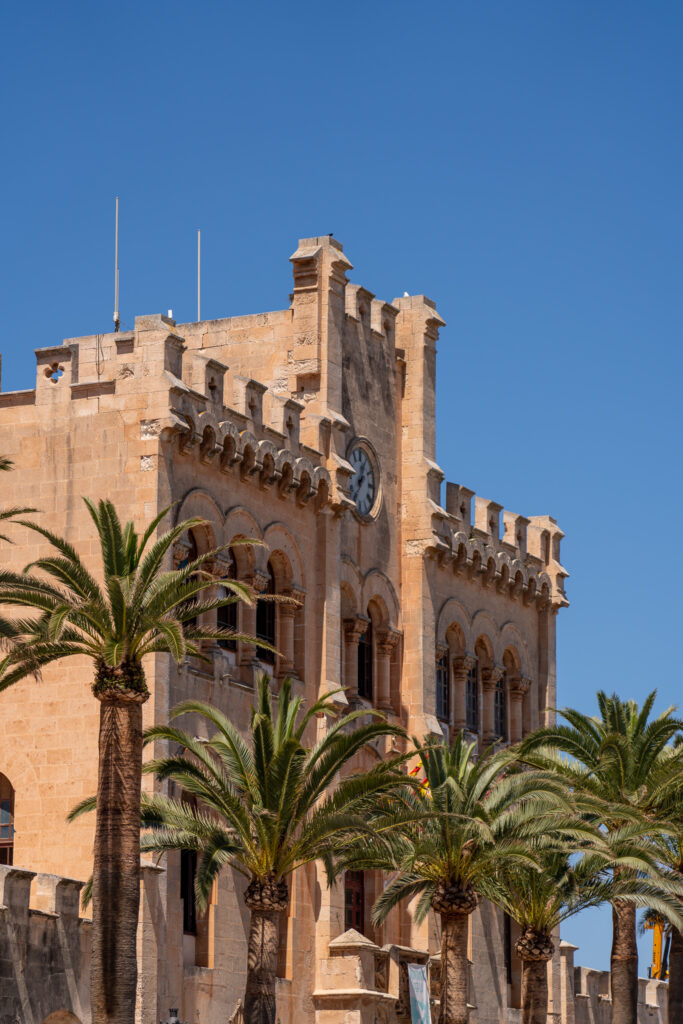
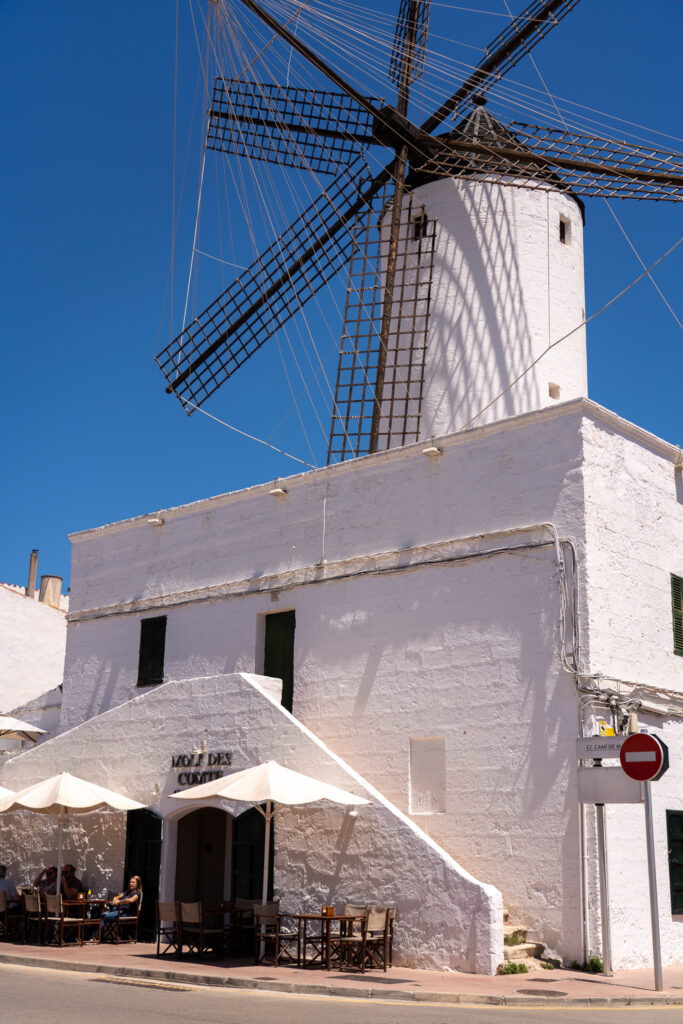
Spend time browsing the Municipal Museum, gaining insight into the Talayotic civilisation who inhabited Menorca during the Iron Age, and for the best views, venture to Castell de Sant Nicolau. The 17th-century watchtower stands sentry at the city entrance and offers outstanding photo opportunities of Ciutadella and beyond.
If you’re seeking historic and cultural things to see in Menorca, Ciutadella is the perfect place to begin your exploration. But it’s also ideal if you just want to soak in the buzz of a larger city, shop in charming boutiques (I love Papillon), or grab a bite to eat from the fabulous market stalls.
Read More: Best Things to do in Ciutadella
TAKE A HIKE ALONG THE CAMI DE CAVALLS
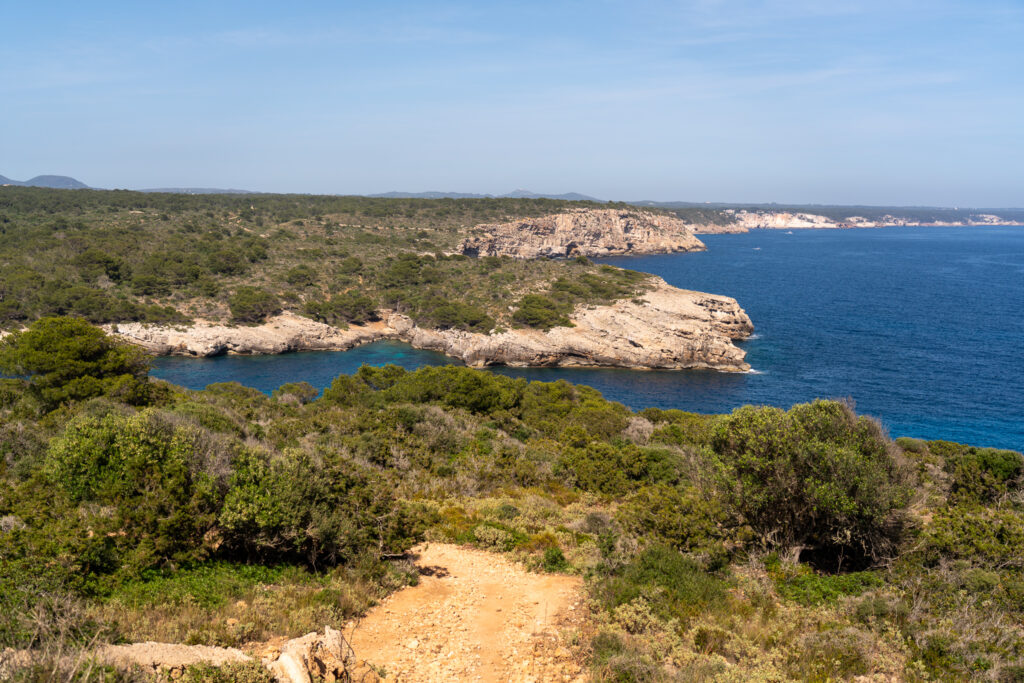
One of the most popular things to do on Menorca is to hike the Cami de Cavalls. The trail, which circumnavigates the entire island, and encompasses 185km in total, has existed since the 1300s and was once a strategic place from which settlers could spot potential invaders approaching from the sea.
Today, there are 20 marked walks of varying lengths and difficulties, leading through pinewoods, teetering close to clifftops and along gorgeous beaches – each section with incredible views. Take a picnic and explore an individual stage of the trail, spending time in nature with just flora and fauna for company (and the occasional goat or wild pig).
One of the shorter (and easier) routes navigates the flat terrain from the lighthouse at Punta Nati, following the cliffs towards Pont d’en Gil (a natural sea arch) en route to the old port of Ciutadella. The trek takes around 1.5 hours (one way).
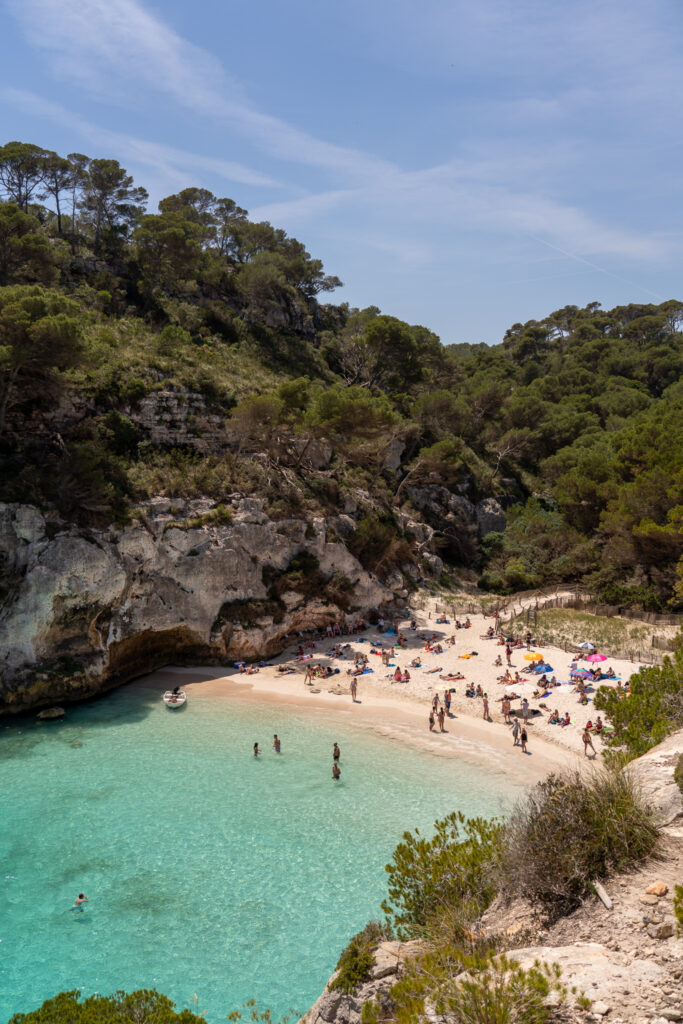
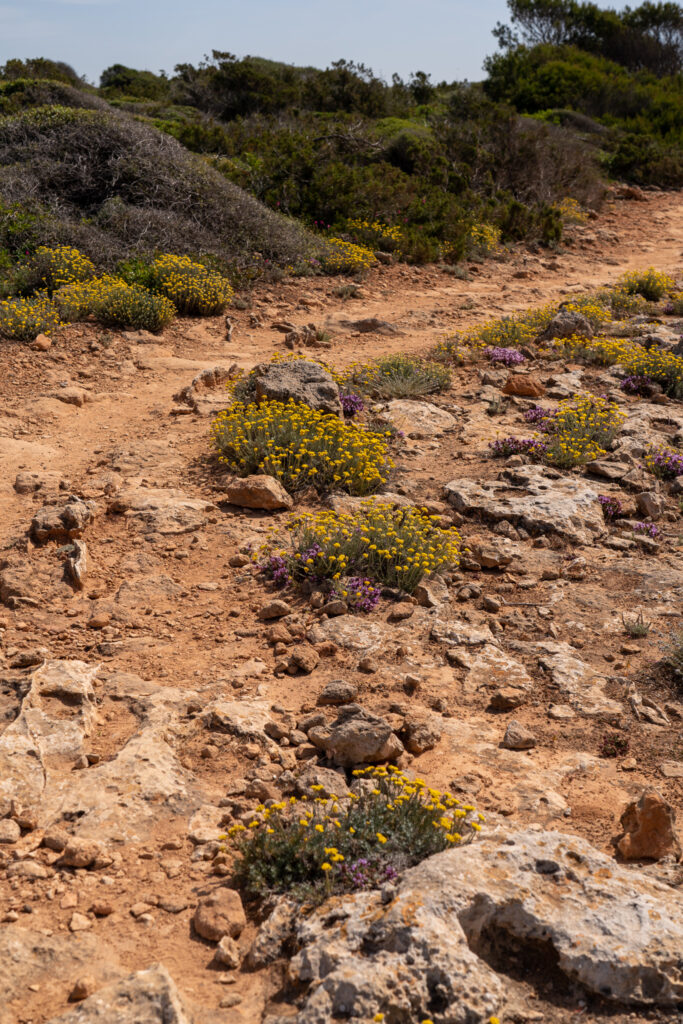
Some of my other favourite sections of the Cami de Cavalls include the following:
– Walking from Cap D’Artrutx – Cala Macarella. This section officially goes right through to Cala Galdana, but if you’re walking out & back (as I did), Cala Macarelleta makes an excellent mid-way point for a swim and rest. It’s one of the most beautiful beaches on the island, and well worth the effort to get there!
– Cala Galdana to Sant Tomas. This section also takes in some excellent beaches, including the beautiful and remote Cala Escorxada. You can choose to take the Cami de Cavalls the whole way, or mix in some coastal sections too (I did the inland route in one direction, and the coastal route in the other direction to mix things up!).
– Far de Favàritx to Es Grau. This is only around 10km of a larger section, or you could push on to Sa Mesquida. This section is one of the quieter routes you can follow, and the beaches here are wild and rustic.
Honestly, it’s hard not to list all the trail sections here, as it’s all incredible. So you really can’t go wrong, with whichever length you choose to complete.
GET ACTIVE IN MENORCA
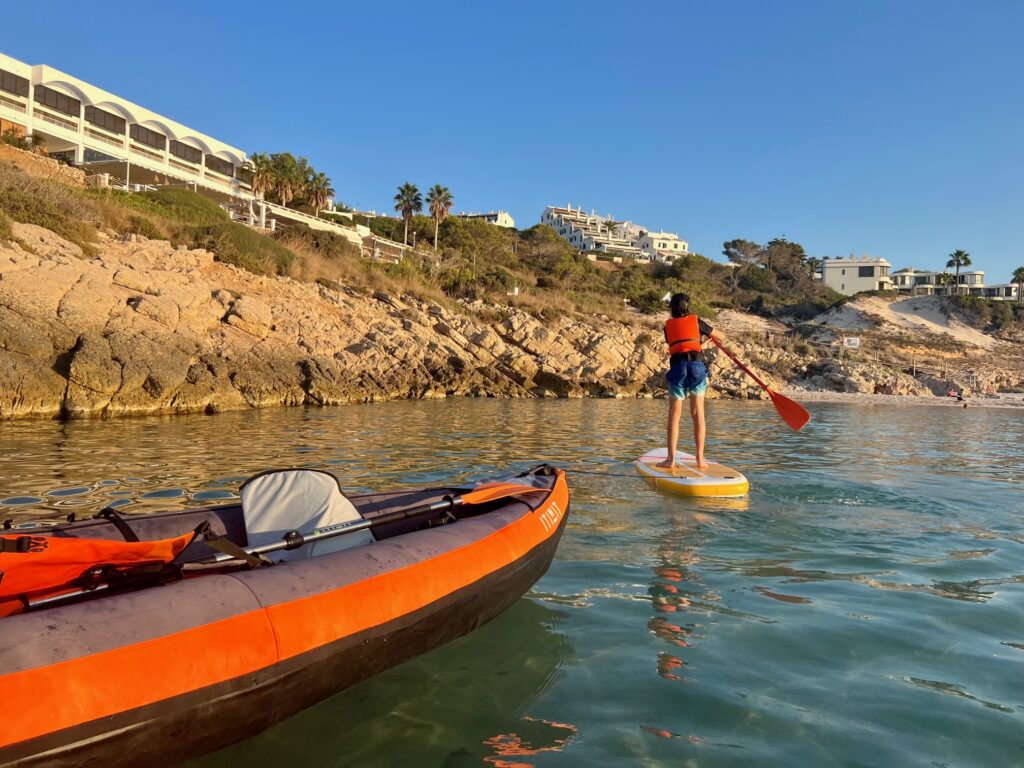
There are plenty of things to do in Menorca for families, and most of them include outdoor activities. With kilometres of unspoilt rolling countryside, white sand beaches and clear turquoise waters, it’s easy to see why this island is an outdoor enthusiast’s dream.
Throughout the year, it’s possible to enjoy mountain biking expeditions to the lesser-known, charming villages of the island. Kayaking and paddleboarding are also popular pastimes – the waters surrounding Menorca are usually very calm, making it perfect for those travelling with kids, and the coastal scenery is beautiful and varied.
Tip – If you’re looking for safe & sheltered bays for paddleboarding beginners, the shallow waters of Son Parc, Arenal d’en Castell and Cala Galdana are all good places to start.
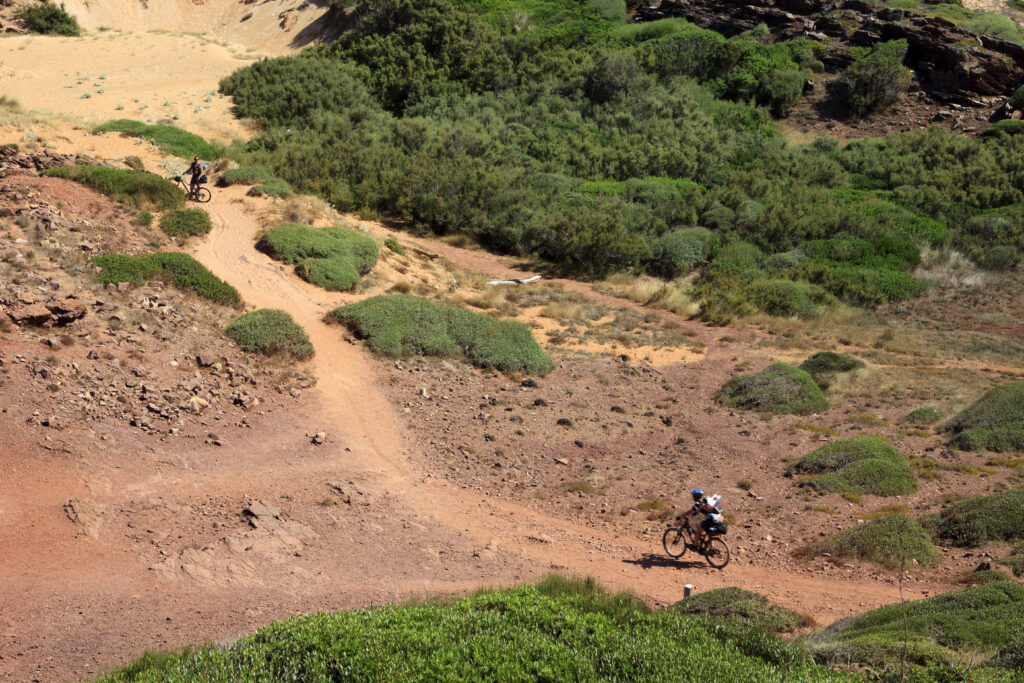
Windsurfing, sailing and horseback riding are also commonly available near most of the popular places to stay in Menorca.
If you wish to explore the subterranean depths of the Mediterranean, go snorkelling or book a scuba diving lesson with one of the island’s expert instructors. The Bay of Fornells is a great place for beginners, there are superb dive spots with reefs and caves and visibility can range up to 30 metres.
TAKE A WANDER THROUGH BINIBECA VELL
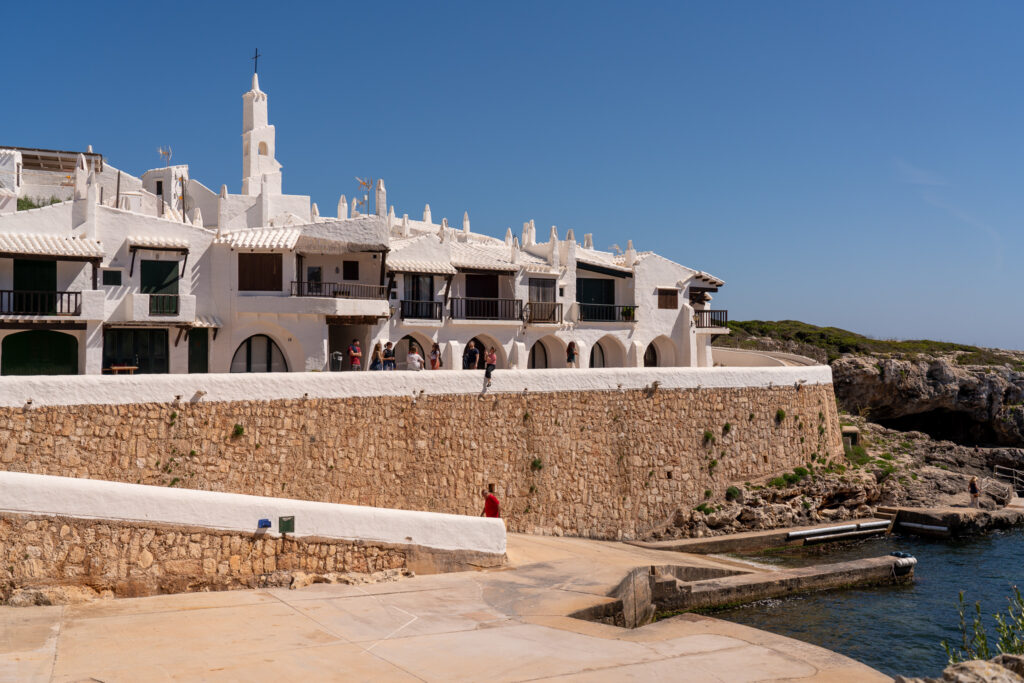
The small fishing village of Binibeca Vell is one of the most interesting Menorca tourist attractions to visit during your stay on the island. But it’s also one of the most popular! So get in early, before the tour buses arrive and enjoy the streets at their quietest.
The whitewashed fisherman’s village was constructed in the 1970s with the purpose of recreating the feeling of living on the island hundreds of years ago. There’s the main square, a small church, a promenade and local markets and shops to browse.
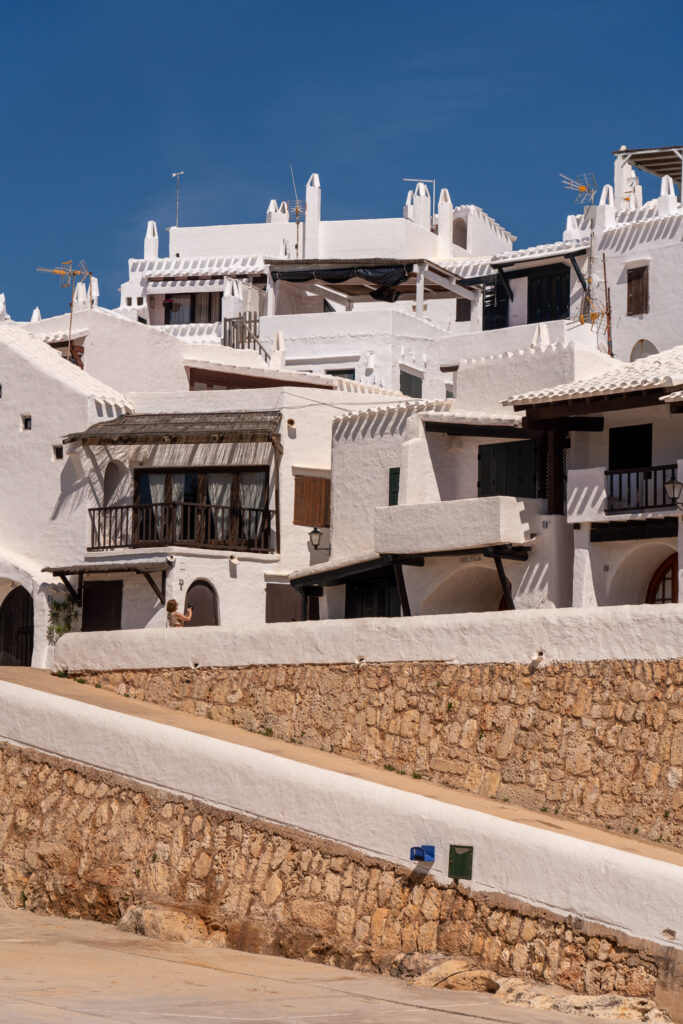
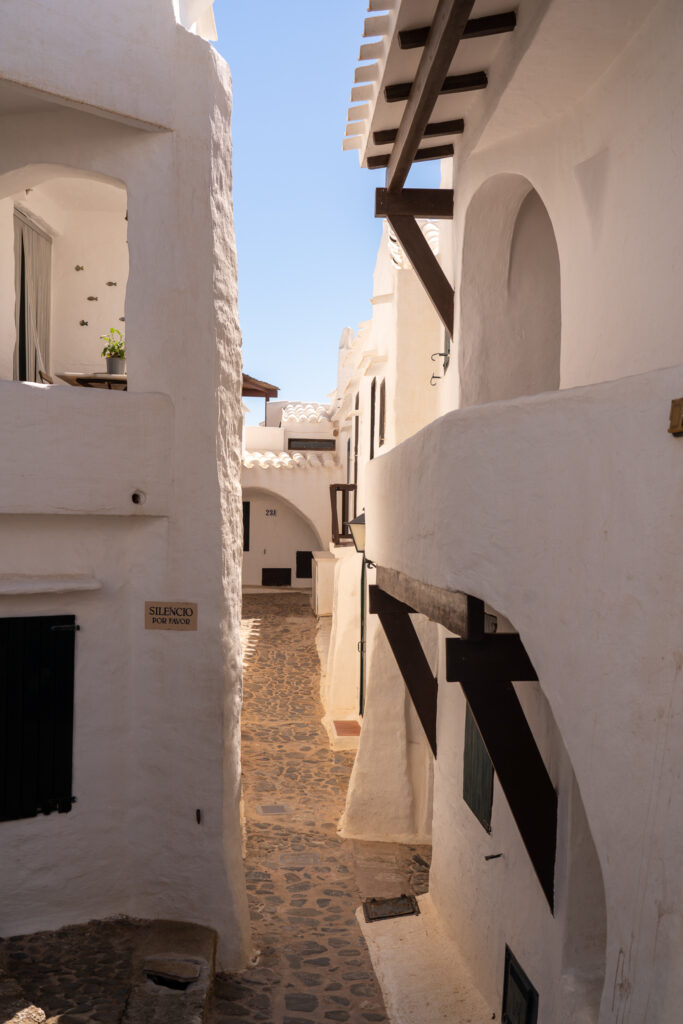
Charming restaurants cater to families with scrumptious Mediterranean fare and nearby, Cala Binibeca invites you to kick back on a sun lounger and soak up the sun after lunch.
Nearby Cala Torret is a superb place for diving too. Daily expeditions that combine snorkelling and kayaking take you into the Marine Reserve of Isla del Aire. Or you can jump on a Catamaran for a more luxurious boat trip experience. Book your sea kayak tour here.
Read More: Visiting Binibeca, Menorca
VISIT THE STONE LABYRINTH AT LITHICA
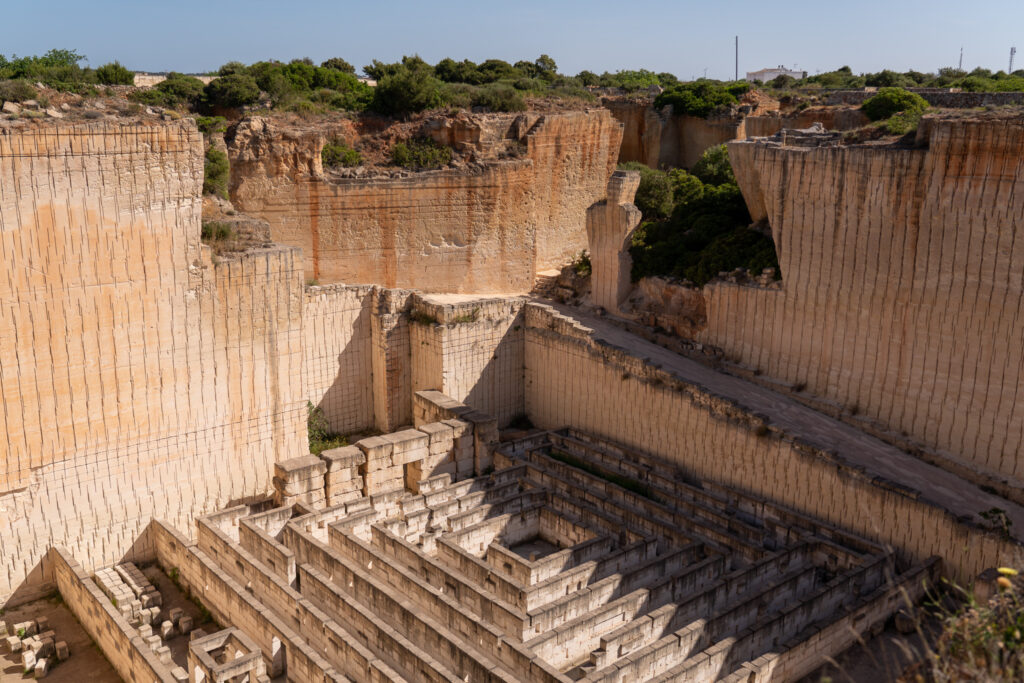
Looking for things to do in Menorca with kids? The stone labyrinth at Lithica will easily keep little ones (and adults) occupied for a few hours.
Lithica was constructed to preserve the old limestone quarries on the island which were initially destined to basically become landfills. Today, they have been transformed into a recreational and cultural area with stunning gardens and a giant stone labyrinth.
Wander along pathways, see the irregular shapes of towering stone limestone walls, enjoy a masterclass in the healing properties of medicinal herbs and admire local flora before losing yourself in the labyrinth for a while.
SPEND AN EVENING AT COVA D’EN XOROI
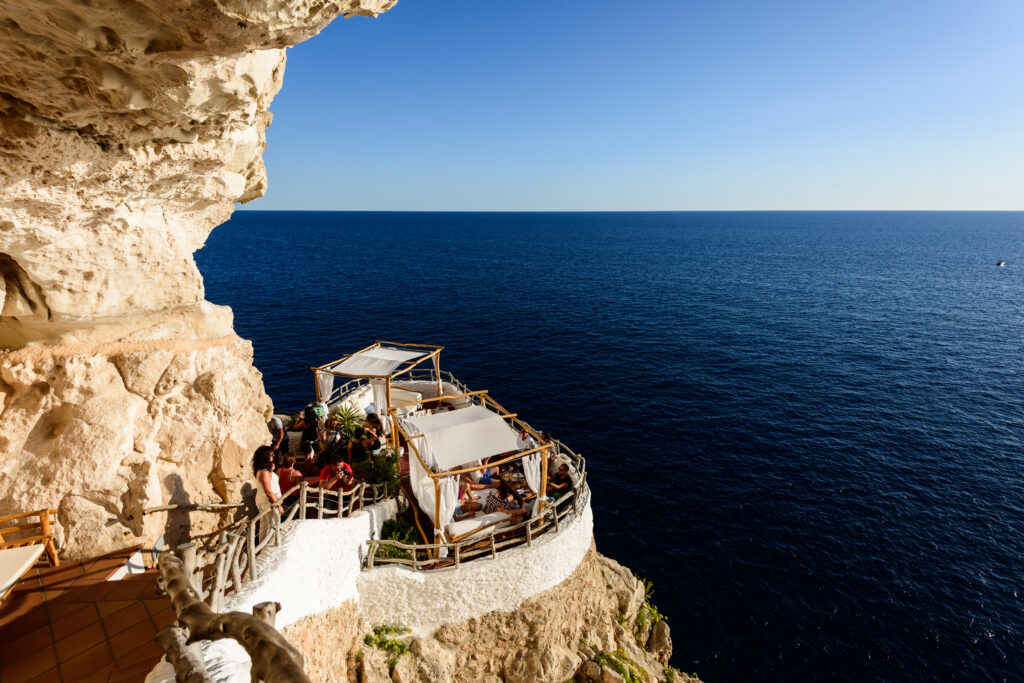
Hidden on the side of a cliff face in southern Menorca, near the perfect sandy cove of Cala en Porter, is where you’ll find Cova d’en Xoroi. Local legend dictates that the cave was named Xoroi after a Turkish pirate who hid in the grotto to avoid being caught for plundering nearby villages.
Today, it’s an interesting place to explore during the daytime. Atmospheric corridors connect the different spaces inside, leading you to conjure stories and tales of your own. You can listen to myths and enjoy incredible views, but it’s after dark the cave really comes to life.
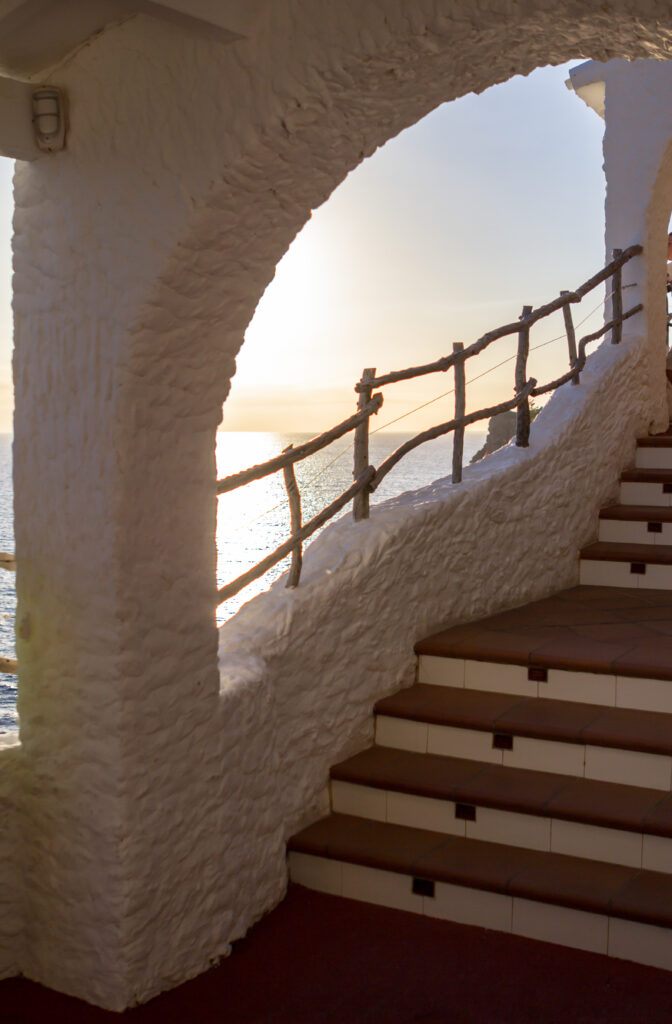
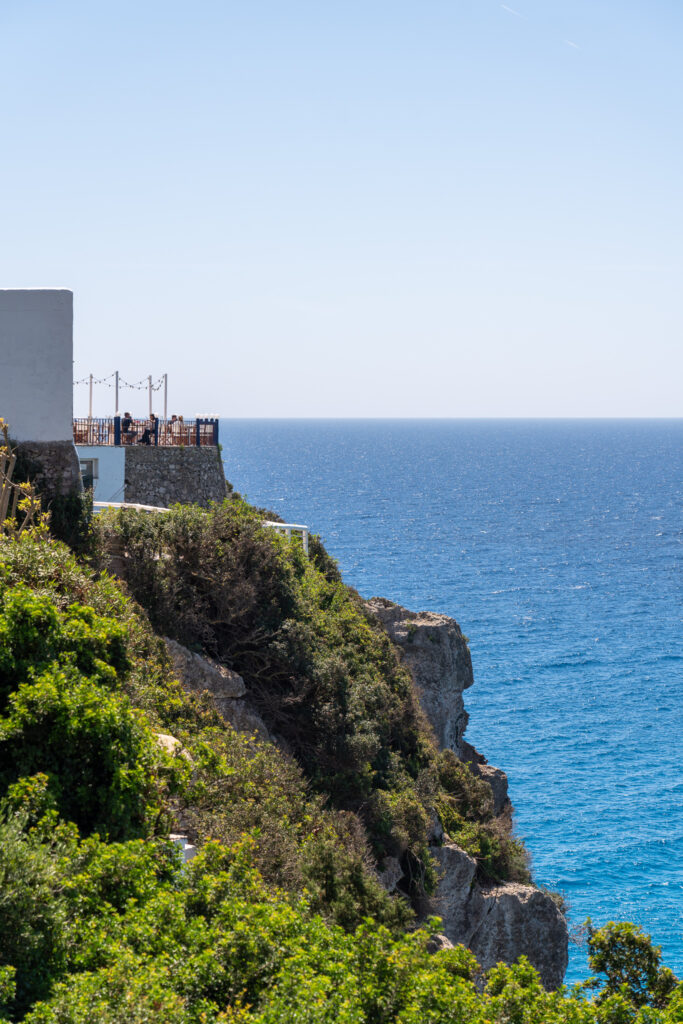
Arrive just before sunset and settle in to enjoy cocktails, live music or dance until the early hours, experiencing one of the island’s most popular (and unusual) venues. It is by far one of the most fun things to do in Menorca at night, after all, who can say they partied inside a cave!
Just be sure to book your spot in advance, or you may not be guaranteed entry, especially in the busier summer months.
SHOP, SIGHTSEE AND DINE IN MAHON
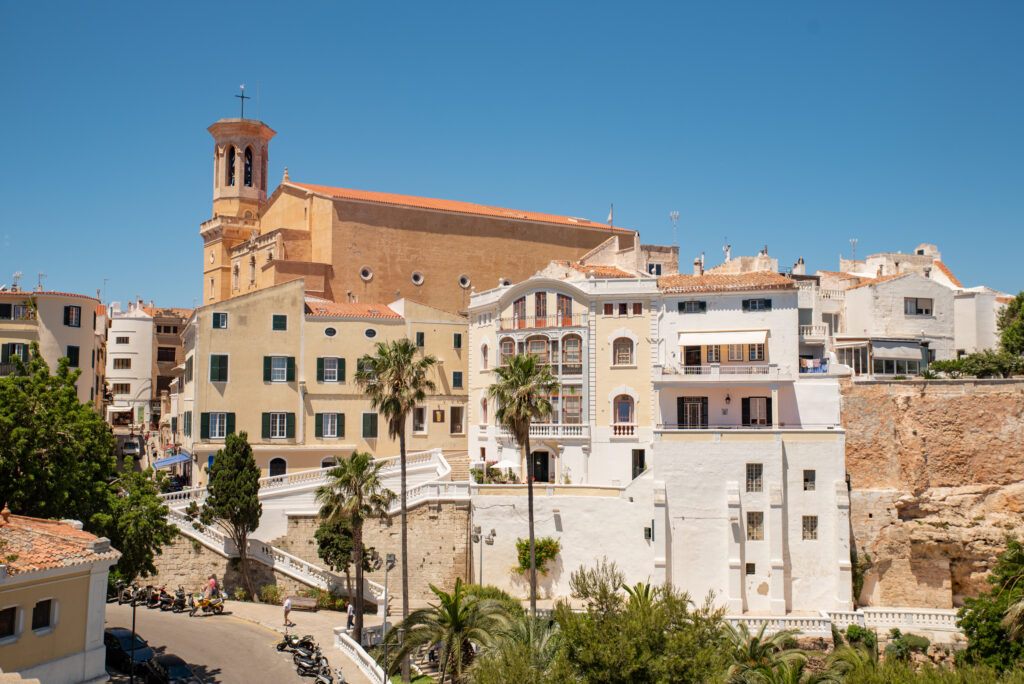
Mahon, also known by its Catalan name of Maó, is the easy-to-navigate, picturesque capital city of Menorca. It’s possible to cover the entire city on foot and there’s much to see and do in this city, making it one of the best places to go in Menorca – especially for first-timers to the island.
Set sail from the harbour to view ancient fortifications, colourful buildings and tiny islands from the water. Alternatively, head for the fascinating Museum of Menorca, set inside a 17th-century monastery, where you can immerse yourself in the history and culture of this beautiful Balearic Island.
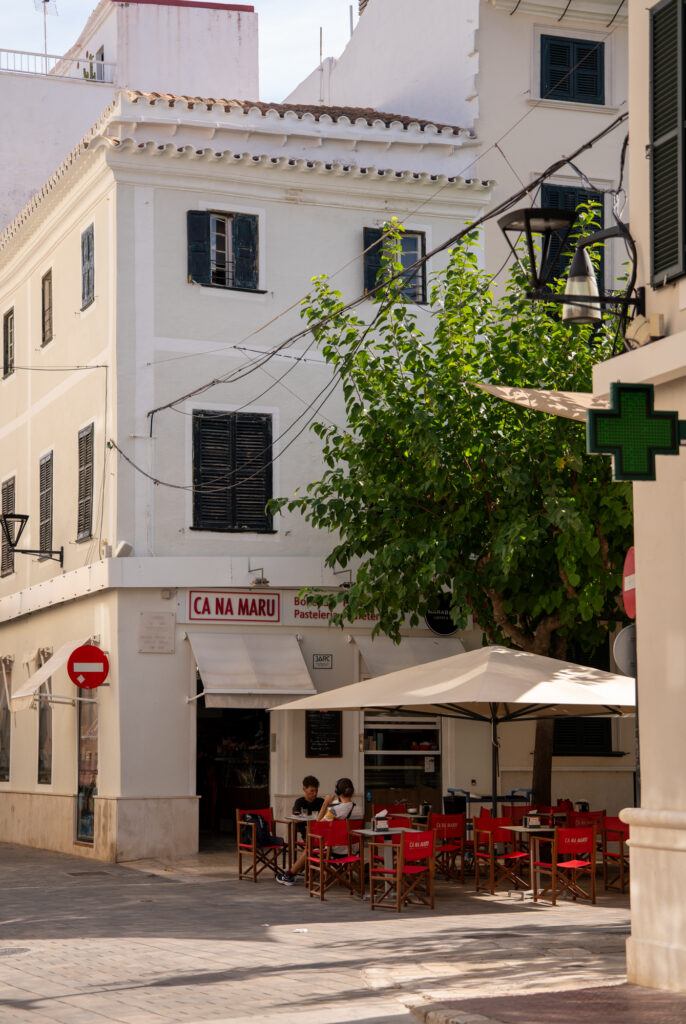
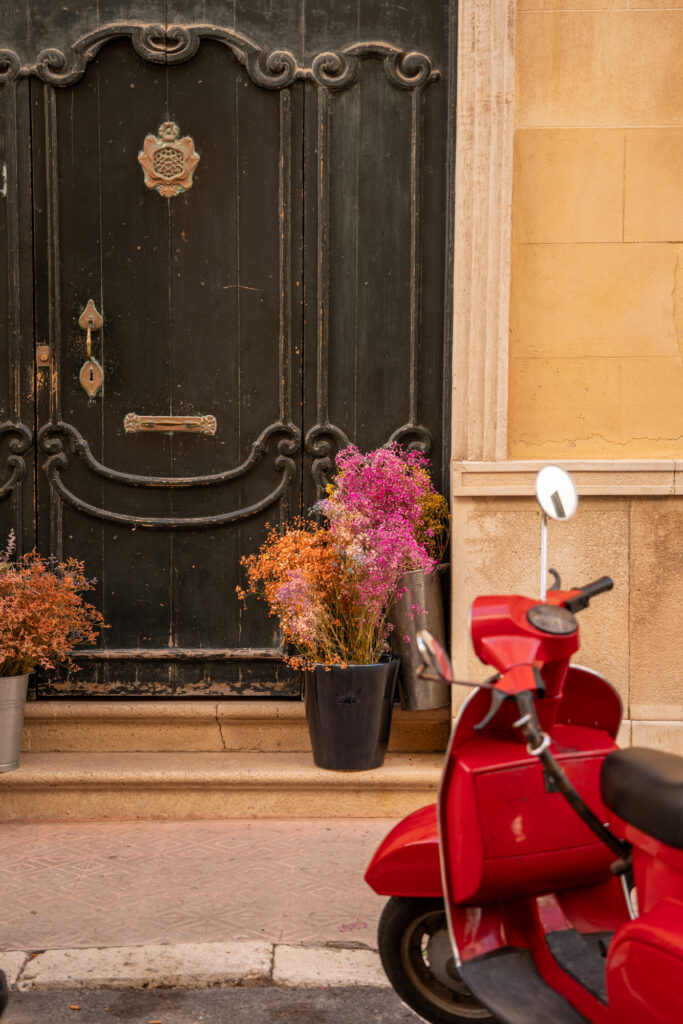
Menorca is famed for its shoemaking, and in Mahon, you can pick up a pair of handmade Menorquinas or Avarcas. These, the traditional sandals of Menorca, are must-have items of footwear for strolling the streets of Mahon.
Cuisine connoisseurs will also enjoy a trip to the culinary capital of Menorca. It’s rumoured to be the true birthplace of mayonnaise, the creamy condiment that goes with almost any dish, and you can enjoy a refreshing bowl of Oliaigu (similar to gazpacho) on a hot day.
Visiting Mahon in the evening? Stop on a lively terrace for a glass of Xoriguer gin, one of Menorca’s most famous exports.
Read More: Best things to do in Mahon, Menorca
VISIT HAUSER & WIRTH ON ILLA DEL REI
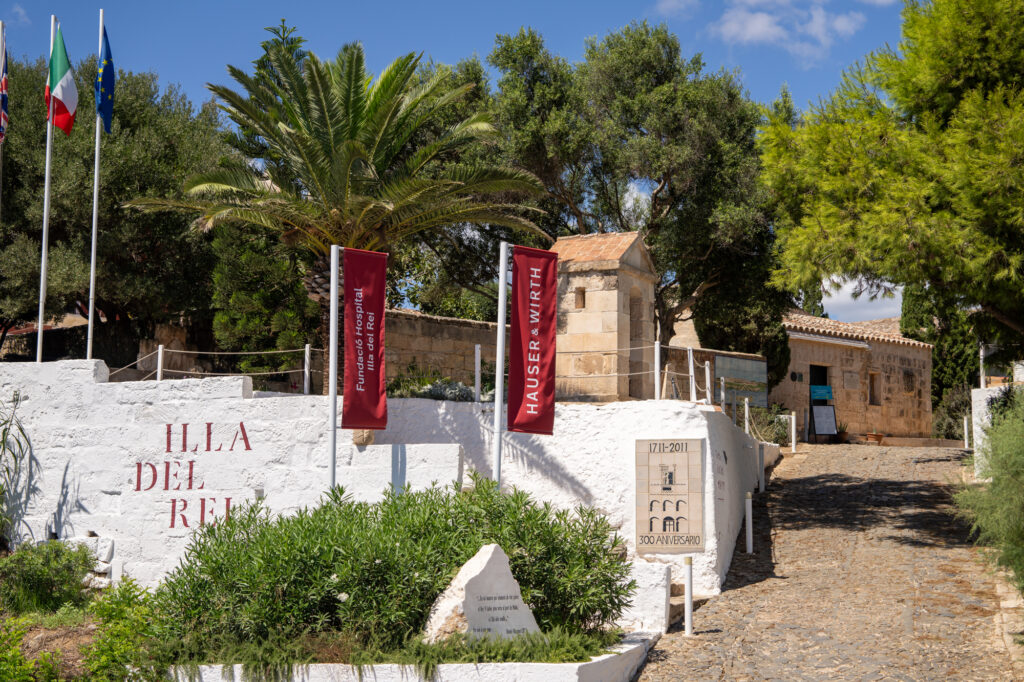
A short ferry ride from Mahon port, you’ll find the recently opened art centre, Hauser & Wirth. Located on the Illa del Rei (the King’s Island) – a lush oasis in the middle of the Mahon harbour – the site was once home to a British Naval Hospital.
The hospital, which was built in the early 1700s, has been restored and turned into a museum by local volunteers, and the other buildings on the island have been repurposed into art galleries by Hauser & Wirth.
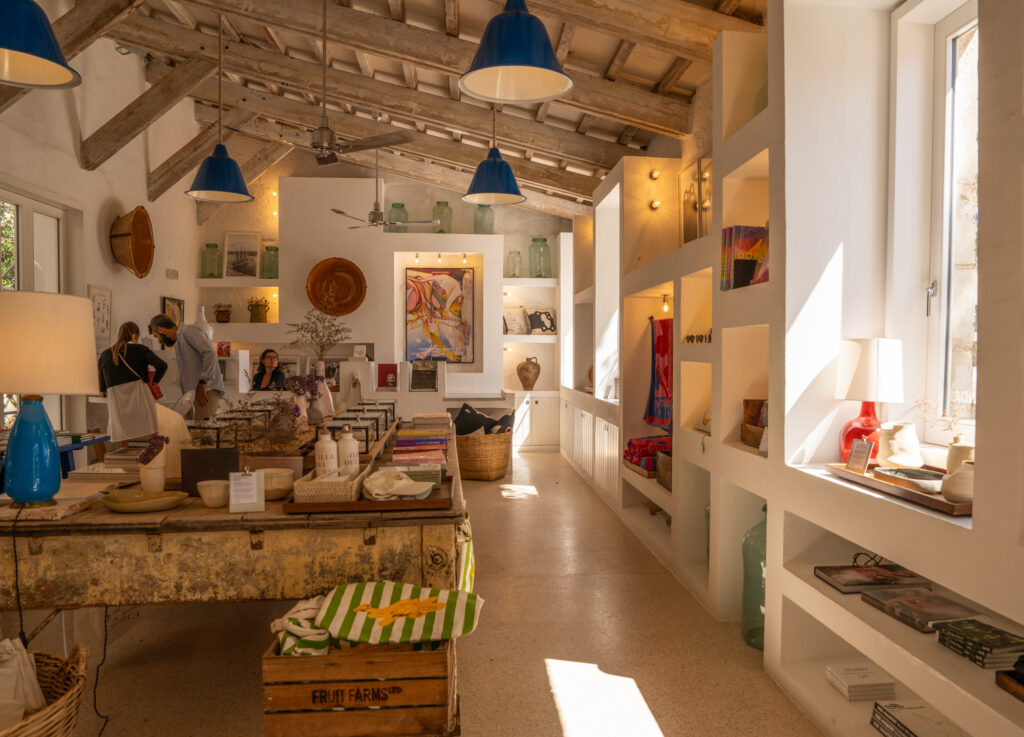
The ferry takes 15 minutes and departs Mahon port on the hour. Upon arrival, take your time to browse the art exhibitions, walk the sculpture trail, and discover the stories within the Naval Hospital Museum.
Once you’ve worked up an appetite, take a seat under the shade of wild olive trees, and dine on fresh, local produce that’s been skillfully prepared. Finally, visit the gift shop for a thoughtful souvenir, before jumping back on the ferry for your short trip back to Mahon.
Tip – Ferries depart from Moll de Llevant 61 (by the glass bottom boat) every hour. In peak times, it’s advisable to book in advance on their website, but not absolutely necessary as you can also buy tickets on board. Ferry tickets cost €10 return, the exhibitions are free.
RELAX ON A SECLUDED BEACH
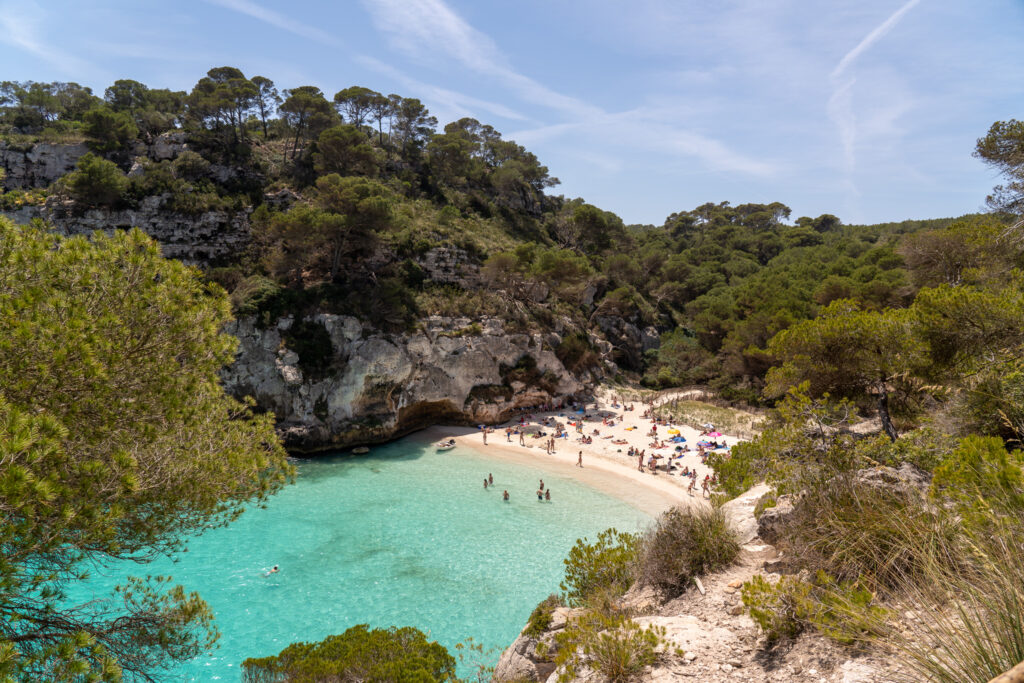
Menorca’s coast is punctuated with some of the most beautiful beaches in the Mediterranean, ranging from large open bays to more secluded spots hidden among pine tree-clad cliffs.
Those along the southern coast are generally the busiest, as they’re famed for their dramatic scenery, lush white sand, and in some cases, ease of access from Menorca’s most popular resorts.
But the beaches along Menorca’s northern coast shouldn’t be ignored either, as they offer a wholly different experience that’s appreciated by the locals.
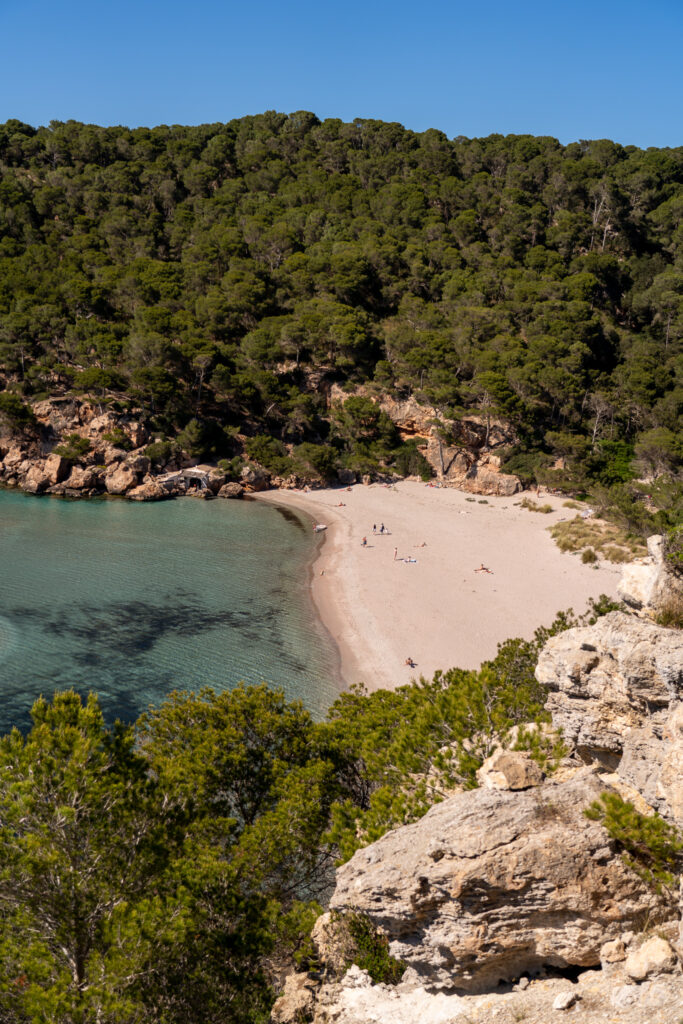
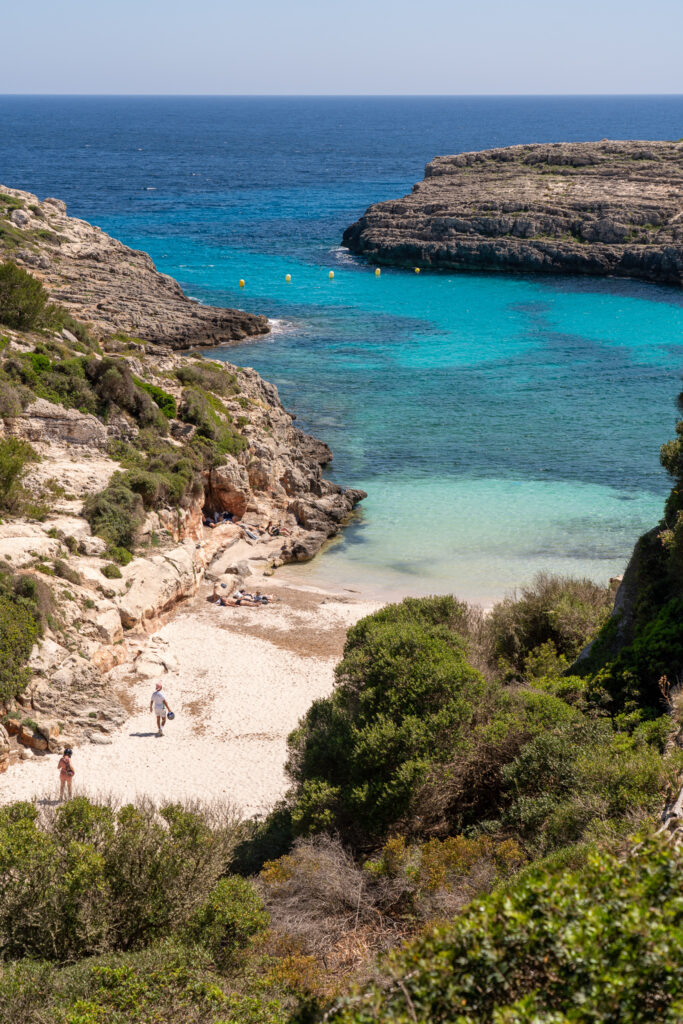
Walk the Camí de Cavalls to relax in the picture-perfect cove that is Cala Macarelleta. Hire kayaks or pedal boats to explore the bay of Cala en Porter. Relax on the family-friendly shores of Cala Galdana. Or experience the red sand wonder that is Playa de Cavalleria. There really is a beach for every mood. And if one doesn’t take your fancy, there’s usually another waiting within walking distance.
Relax at a beachfront restaurant with a plate of tapas or fresh seafood, rent a sailboat or simply snorkel, swim and sunbathe, enjoying some well-earned downtime in a beautifully scenic location.
Read more: Best Beaches in Menorca
CLIMB MONTE TORO
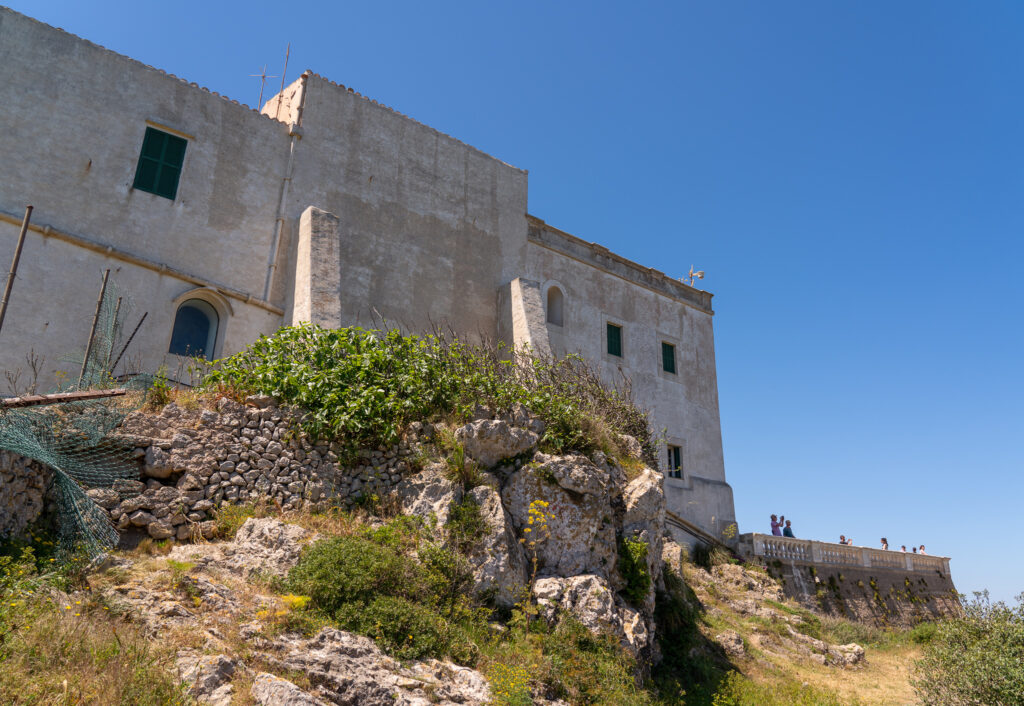
Monte Toro, or El Toro, is the highest peak in Menorca, located almost in the centre of the island 3km from the town of Es Mercadal. It’s a popular location for a day trip, and as it rises to 358 metres above sea level, it’s one of the best places to visit in Menorca for 360-degree vistas of the island.
The mountain is steeped in legend and is spiritually important to islanders. It was once a pilgrimage site, and many would hike to the convent and sanctuary at the summit. Today, it is still home to Sanctuary of the Verge del Toro, a small church dating to the late 1600s, an impressive statue, a gift shop and a restaurant with magnificent island views.
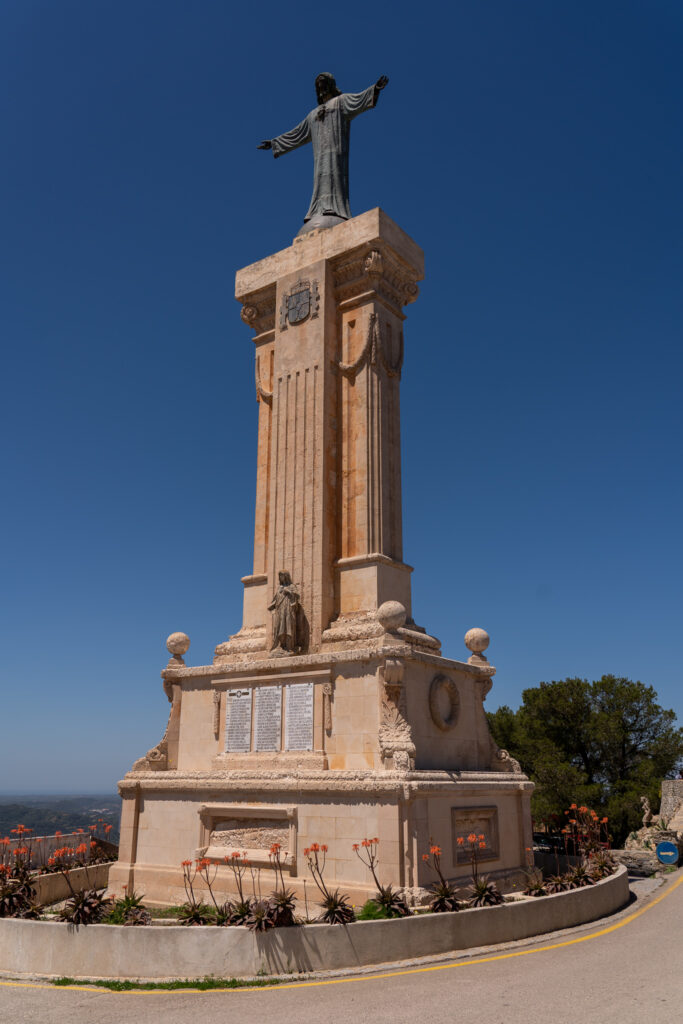
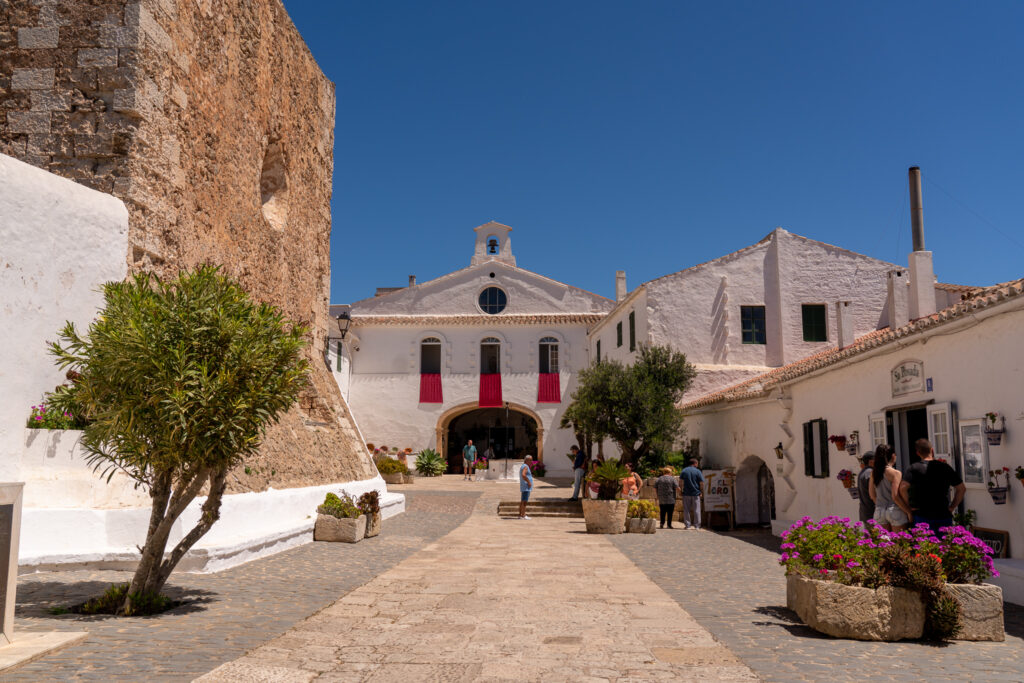
The summit can be reached by car or on foot, and on a clear day you can see the distant mountains of Mallorca, so don’t forget your camera!
CONNECT WITH NATURE AT ALBUFERA DES GRAU
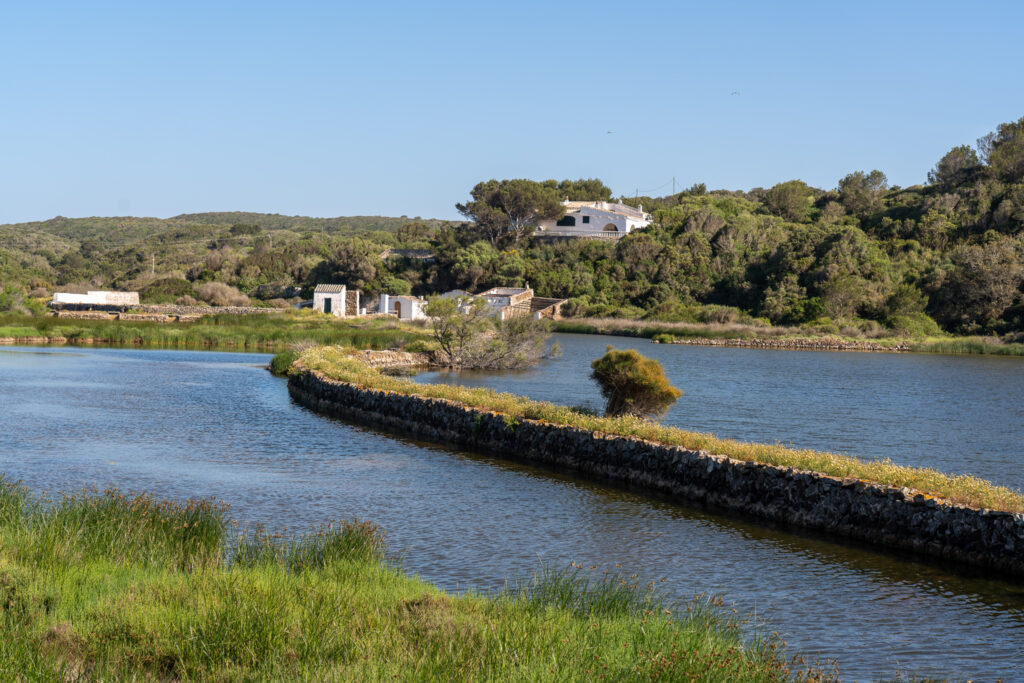
One of the most unique Menorca places of interest is the Parc S’Albufera des Grau, a 5,100-hectare natural park to the northeast of the island. It’s an important part of the island’s UNESCO biosphere reserve status, with diverse habitats ranging from olive groves and wetlands to prairies and coastal islets.
The Albufera des Grau Nature Reserve is home to several endemic species including the Balearic lizard and fisher eagle. Around the lagoon, join birdwatchers attempting to spot rare breeds or admire the high density of flora sprinkled across the woods and farmlands.
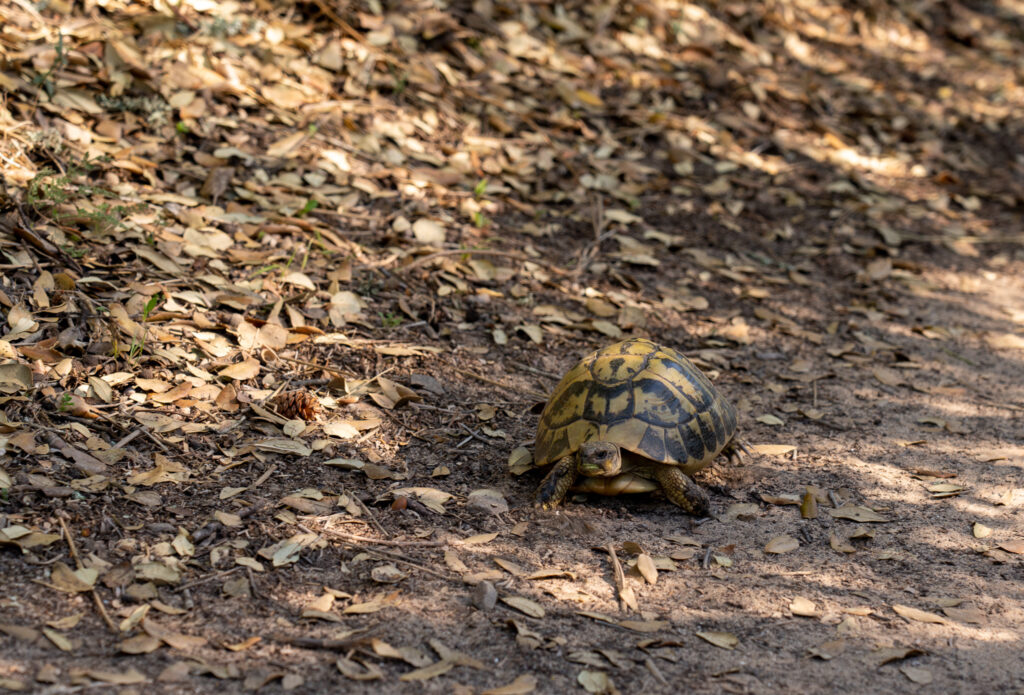
I’ve been lucky enough to spot flamingos feeding in the saline-rich water, and a group of turtles accompanied me along a section of the dusty trail on a recent visit.
Winding pathways are surrounded by lush low hills overlooking the tranquil waters and there are natural pools and beaches nearby for relaxation. On your return journey, stop off at Es Grau, a picturesque fishing town on the edge of the park for drinks or snacks.
DISCOVER THE BOUTIQUE MUSEUM, MUSEO BINISSUES
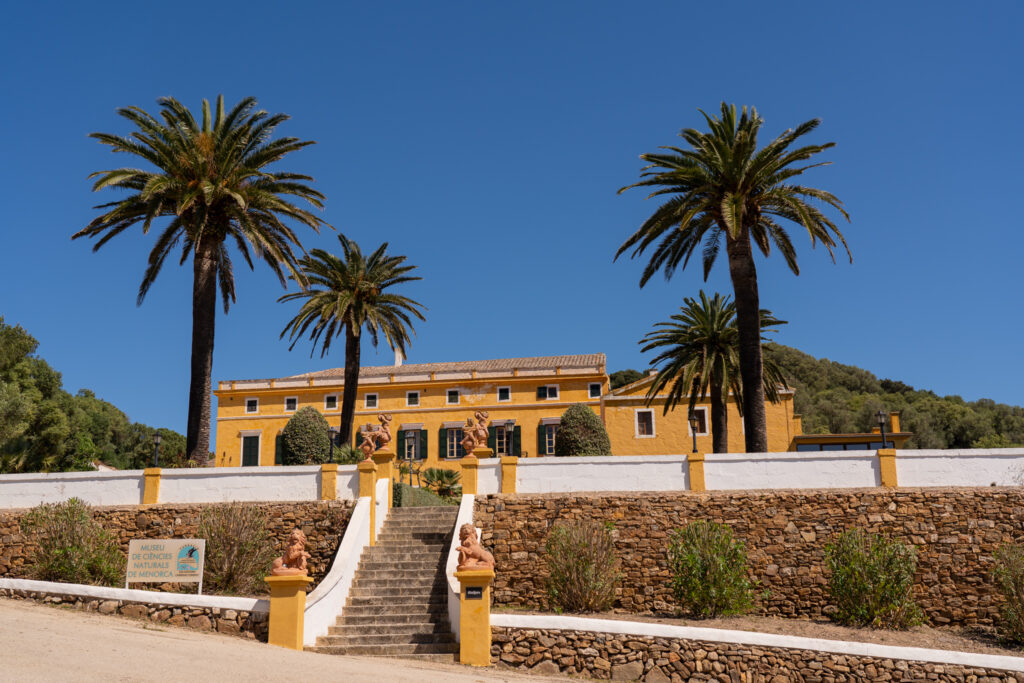
Located a short detour off the main road that runs the length of Menorca, lies this truly special museum. One of the most interesting Menorca attractions, yet one of the least visited (if my experience was anything to go by), the Museo Binissues is a Museum of Natural Sciences, but it’s also a place to observe how the Menorcan people used to live, work, and farm.
The museum is divided into different sections, starting with a tour of an 1800s stately home, then into the Natural Sciences Museum, and then finally into a country house and ethnological collection.
The collection of butterflies, spiders and beetles is truly impressive, and is among the most important collections of its type in Europe.
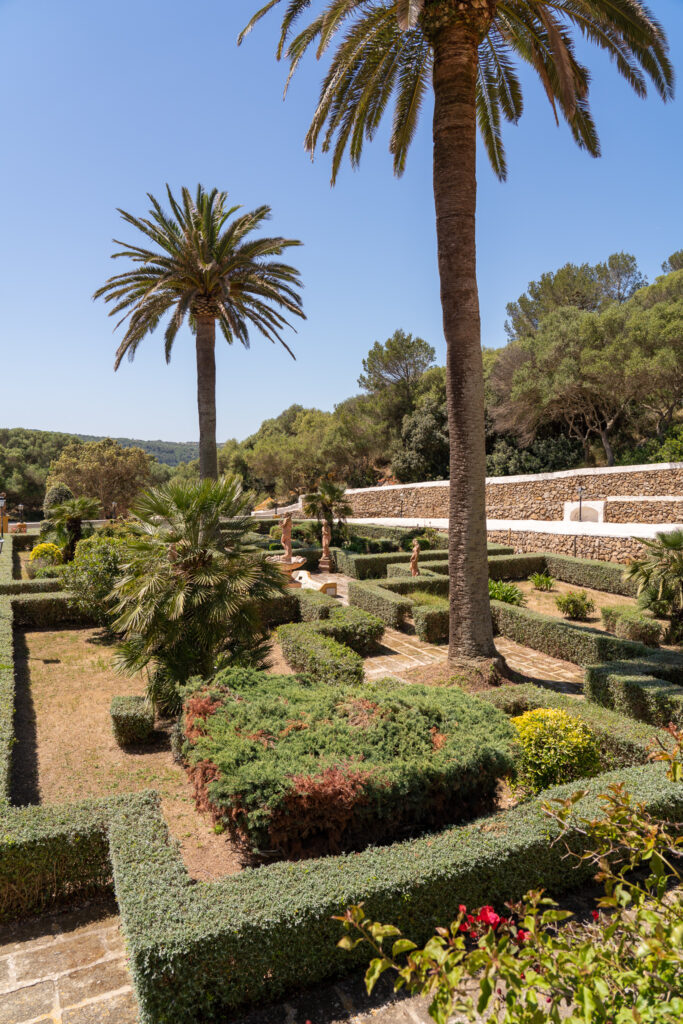
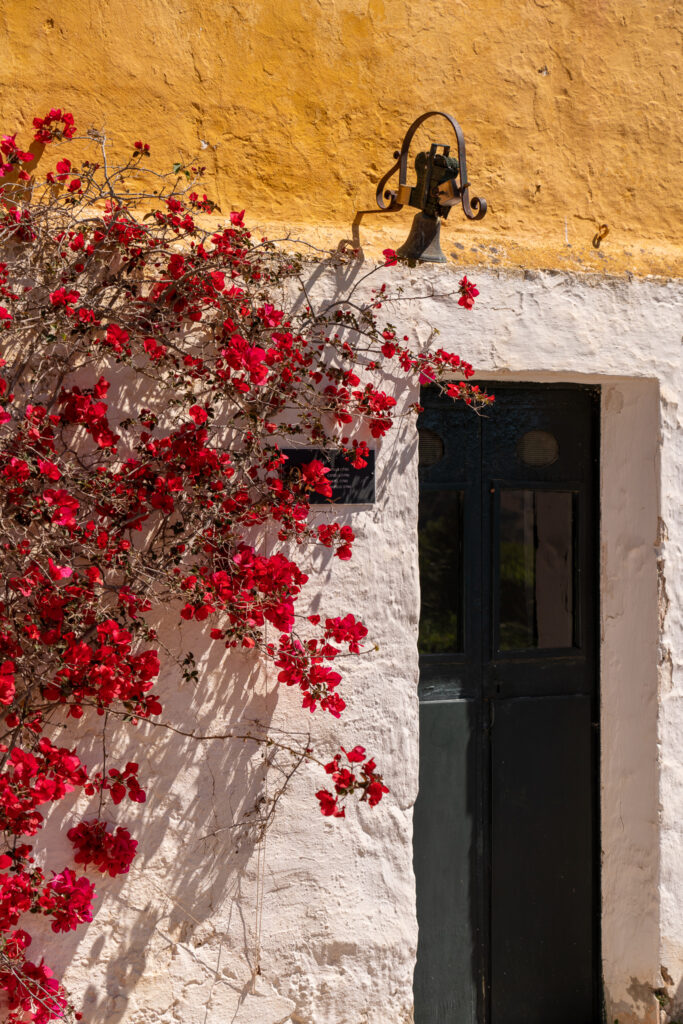
In the summer months, you can book a show and learn Menorcan traditions hands-on, such as baking bread, cheese making and more.
Outside, the spectacle continues, with stately gardens that delight the senses, and you can wander while you’re serenaded by birdsong. For the modest entry fee of just €6.50, it’s a worthwhile activity to discover on your trip to Menorca.
SAMPLE MENORCAN WINES
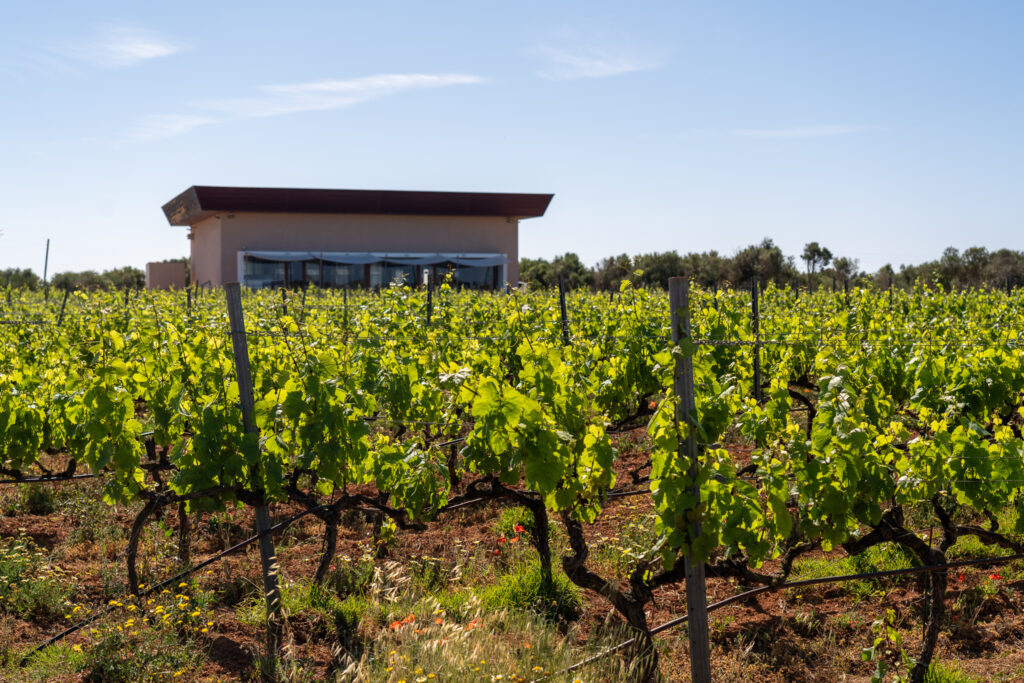
The history of winemaking on the island dates back centuries from when the Moors inhabited Menorca. Today, wine tasting is a popular pastime for tourists, and with several delightful wineries to choose from, you can sample your favourites as you crisscross the island.
One of the best places in Menorca for wine tasting is Bodega Binifadet. Tours and tastings are available, at this, the island’s largest wine producer. With Menorcan sparkling wines high on their list of achievements, this is the perfect winery in which to while away a leisurely sunny afternoon.
Alternatively, if you’re closer to Ciutadella, you will discover Binitord Winery hidden away in an old quarry to reduce its environmental footprint. They produce a variety of wines and a popular vermouth, and tours can be organised in advance (do book in advance or you may find the winery closed, as I did!).
For an authentic wine tasting experience head to Sa Forana. The terroir is rocky, giving their white and red wines a distinct flavour. The family-run artisan bodega produces 13,000 bottles per year, and their vineyard grows Merlot, Chardonnay, Cabernet Sauvignon and Syrah grapes.
VISIT MENORCA’S OPEN-AIR MUSEUMS
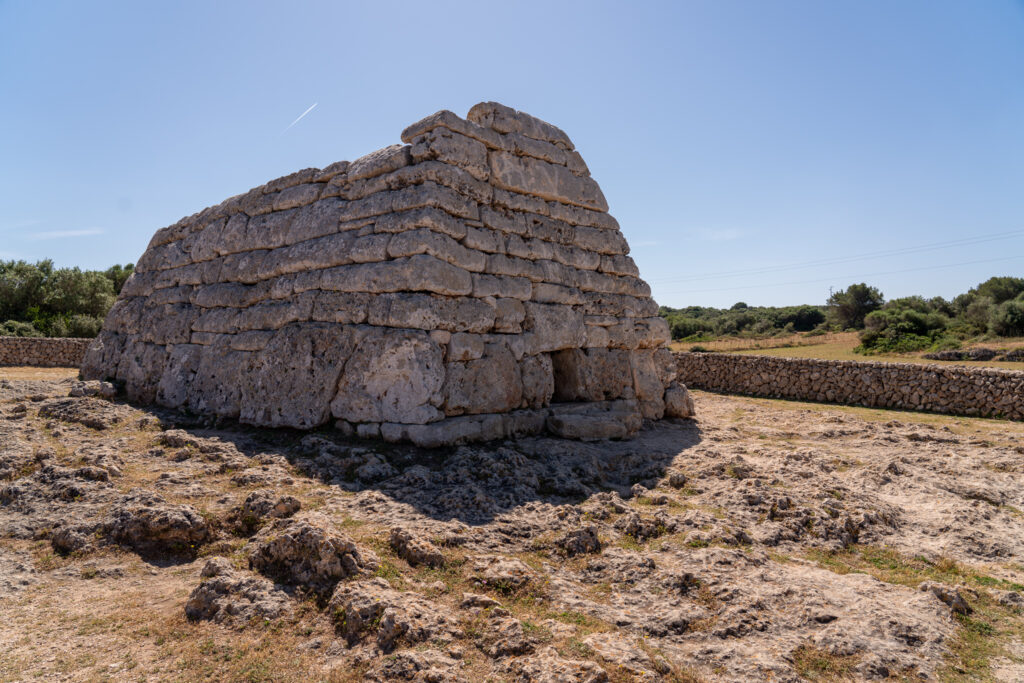
Many millennia ago, during the Iron Age, Menorca was inhabited by the Talayotic civilisation. They built a variety of structures on the island using unusual techniques – placing large stones on top of each other, without using any mortar.
Examples of these structures still stand today. A selection of natural caves, wells, talayots, hypogeums and megalithic tombs can be seen in the many open-air museums across Menorca.
DISCOVER CAVALLERIA LIGHTHOUSE
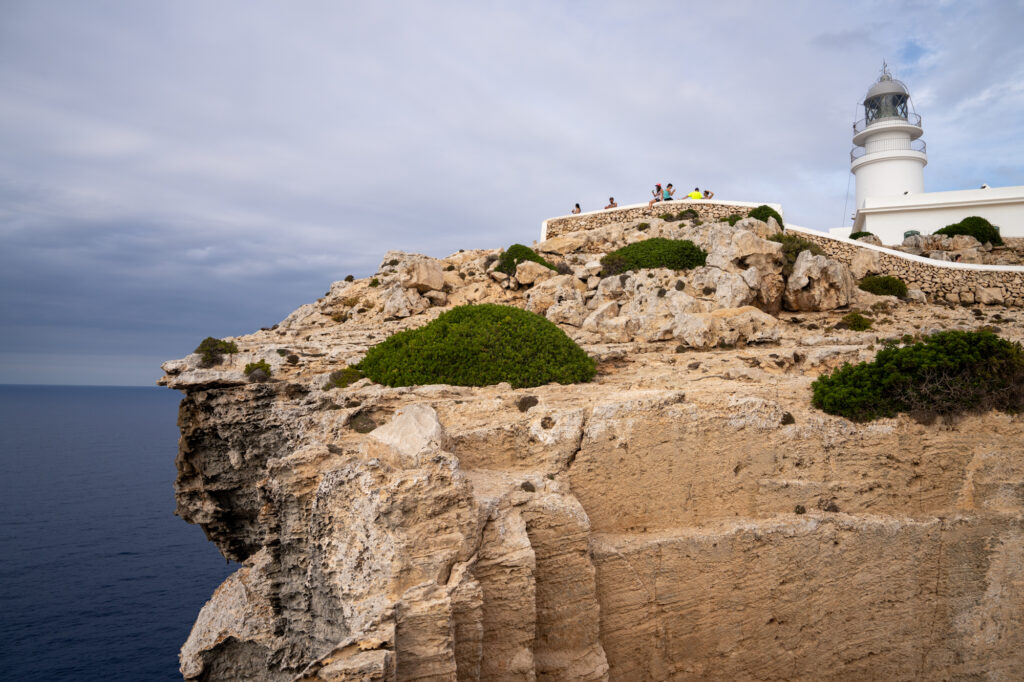
At Menorca’s most northernmost tip, you’ll find the Cavalleria lighthouse sitting tall on the headland. Drive up a narrow road from Cavalleria Beach to reach the imposing structure, and leave your car in the dusty car park.
Seeing as this is a working lighthouse, you can’t climb the tower to see the inner workings. But the small onsite museum is a worthwhile visit to find out more about the island’s history, with a focus on maritime adventures (and misadventures!).
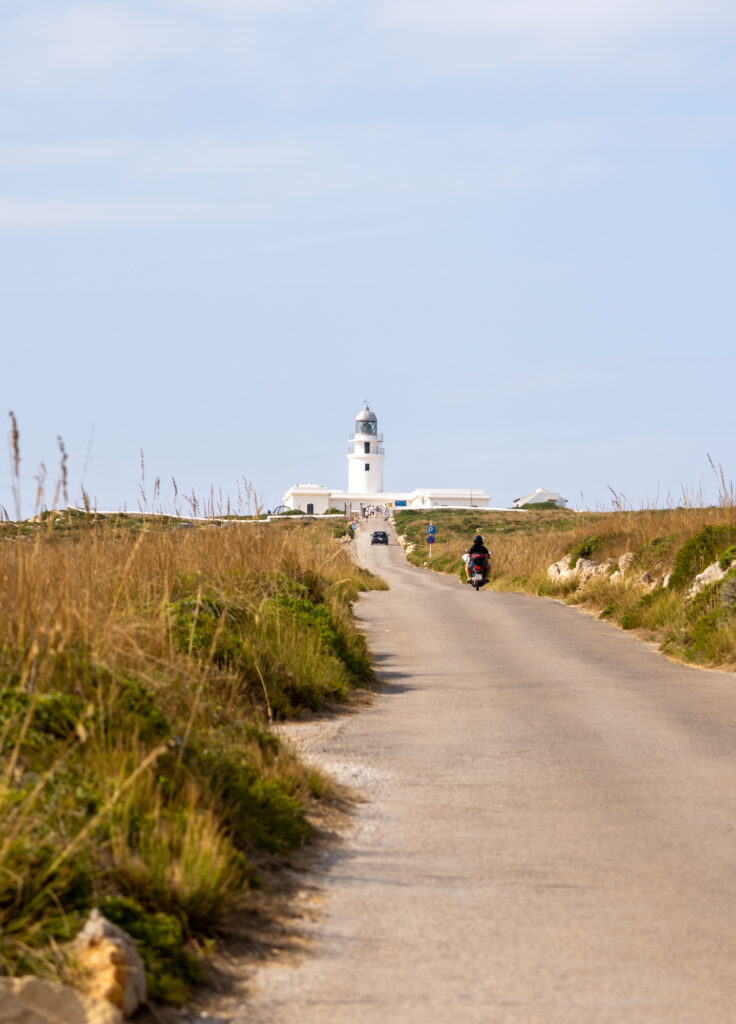
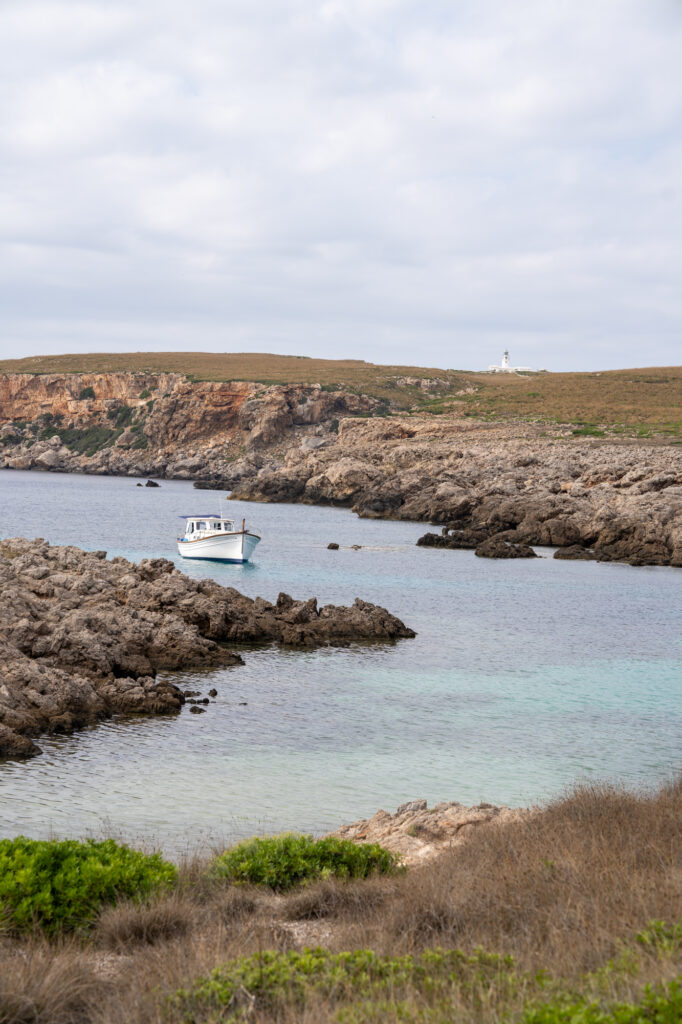
Wander around the headland to discover old military bunkers, delve into the intriguing underground cave that offers dramatic views, pause for a refreshment at the small onsite bar, or visit at sunset for an incredible display of colour.
On the way to the lighthouse, you’ll pass by other places of interest, such as the group of serene swimming coves at Cala Viola de Ponent, and the historic tuna fishing port, Port de Sanitja.
Walking to the lighthouse from Cavalleria Beach allows you to explore the area fully and go off-trail as you please. But as you have to follow the road for some of your journey, I wouldn’t recommend this option during the peak summer months.
EXPLORE THE HIDDEN ‘SMUGGLERS CAVE’
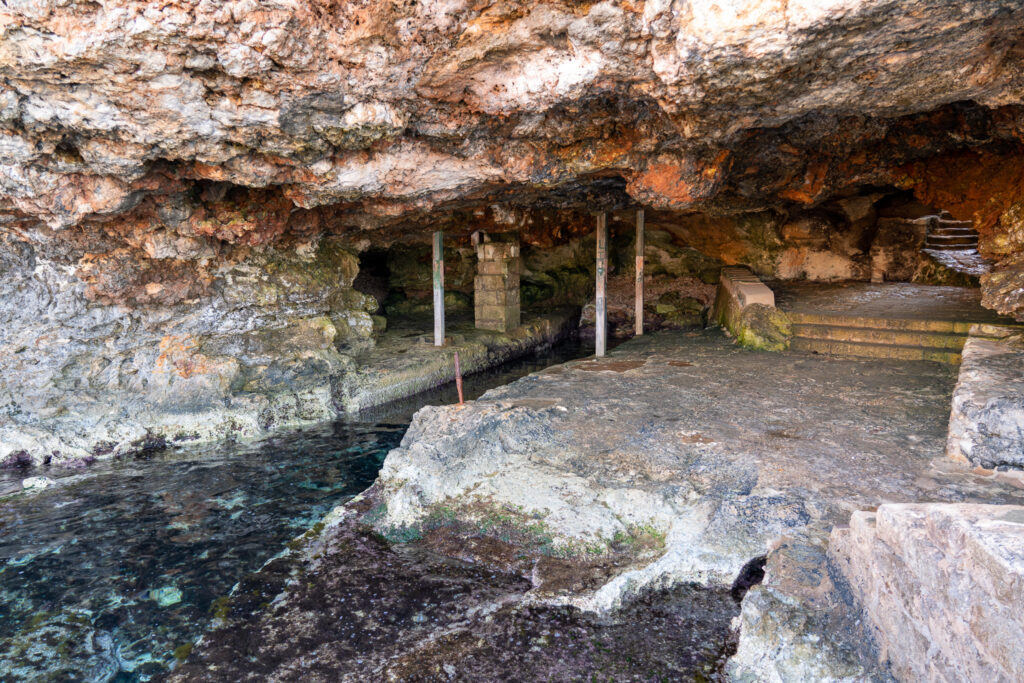
Follow the stairs down into an underground cave that opens up to the sea. There’s a narrow inlet cut into the rock, which allowed boats to come and offload directly into the house above. Be sure to look up, to witness this hole in the roof!
Nowadays, it’s a great place to cool off in mid-summer, swim in the protected bay, snorkel, and sunbathe on the rocks.
FOLLOW FOODIE TRAILS
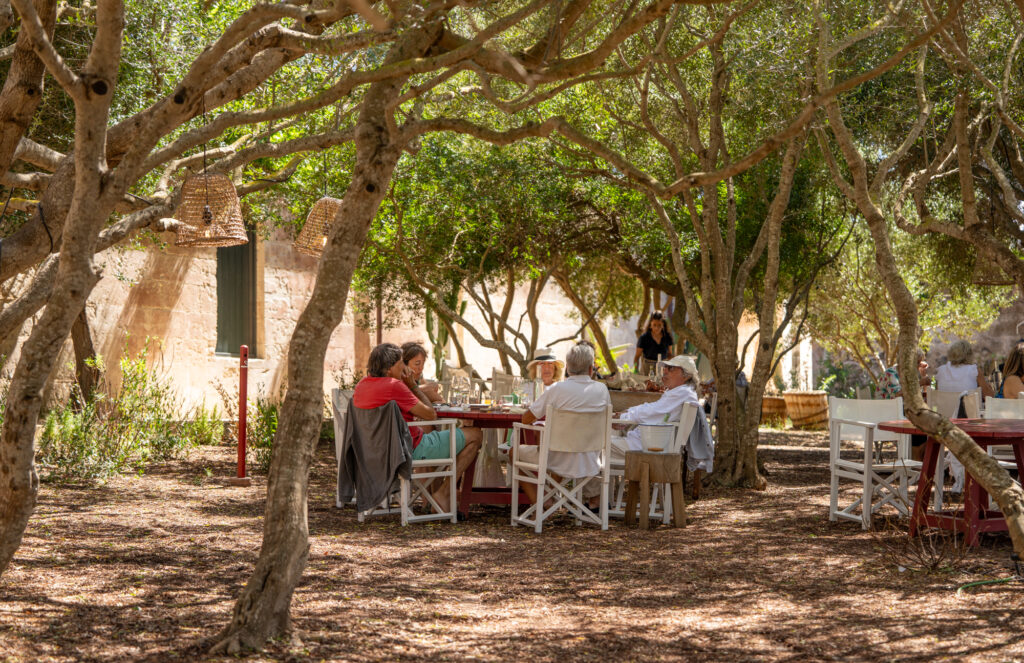
Menorca is fast becoming a top foodie destination with many world-class eateries popping up all over the island. With a climate perfect for growing fresh vegetables, Mediterranean flavours feature heavily on the menu at seaside bistros, rustic farm-to-table eateries, and upmarket cafeterias. Below, I’ve listed some of our picks of the best restaurants in Menorca:
Coral Menorca – seaside dining near Ciutadella.
Menorca Experimental – beautiful outdoor terrace dining and bar at a rustic finca.
Son Vell – farm-to-table dining at a stunning upmarket hotel.
Margot Menorca – casual and delicious tapas in Ciutadella.
Bar Pasaje de Madrid al Cielo – authentic tapas bar in Mahon.
En Caragol – upmarket dining in Sant Lluís.
Son Blanc – a sustainable farm-to-table restaurant within a beautifully restored farmhouse.
As you can see, there are so many cool things to do in Menorca – from diving and sailing, and discovering local wine and cuisine to visiting archaeological sites and biodiverse landscapes. Should you still require further information or inspiration, check out all our Mediterranean guides here.

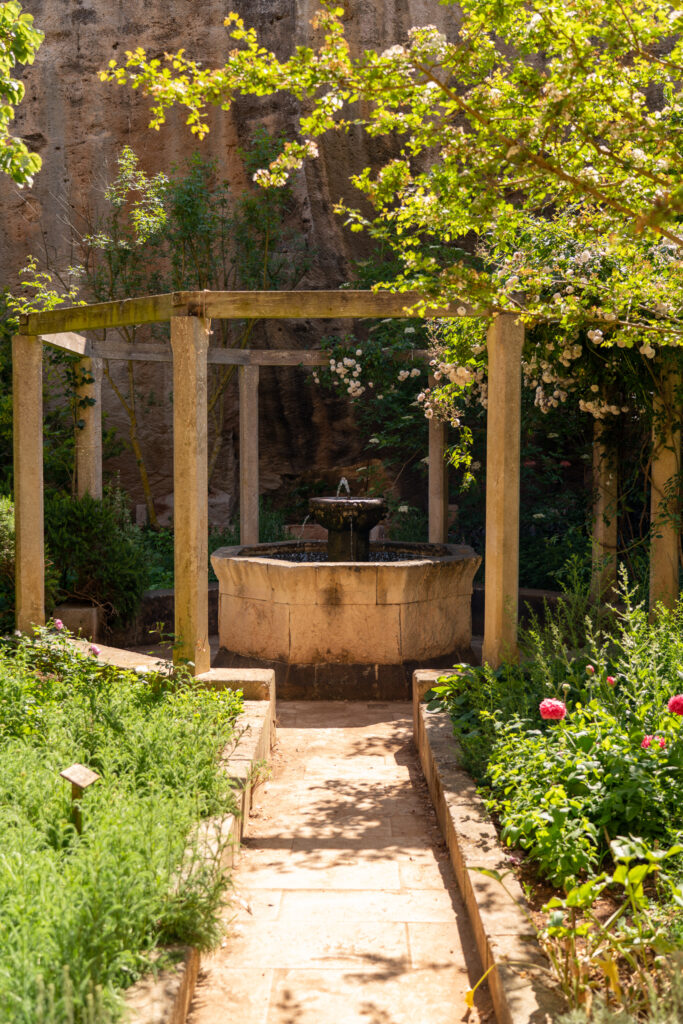
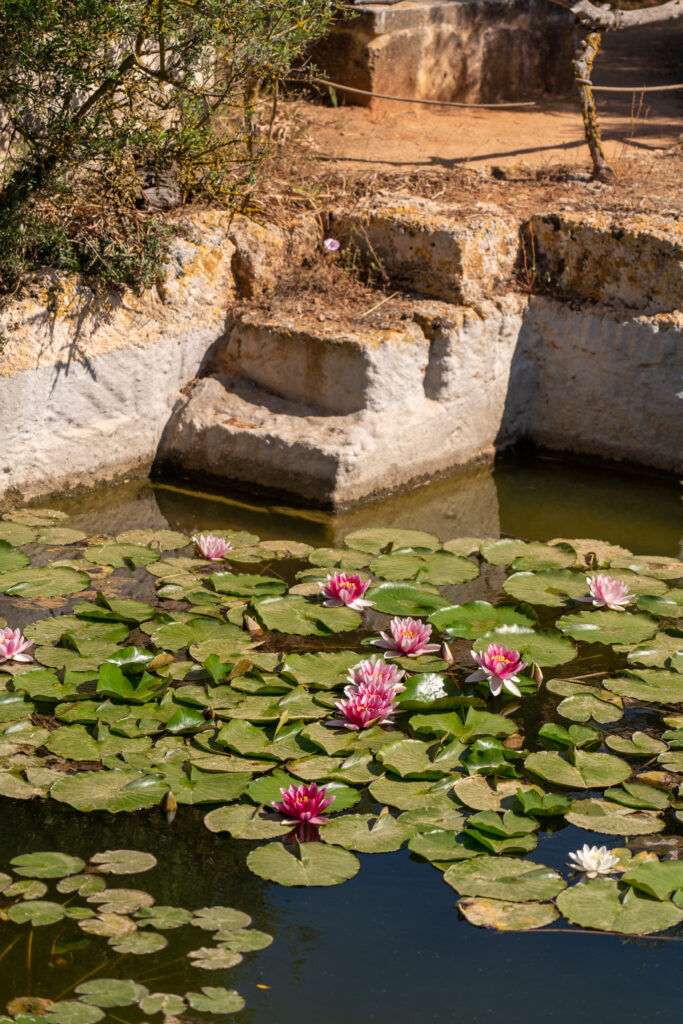
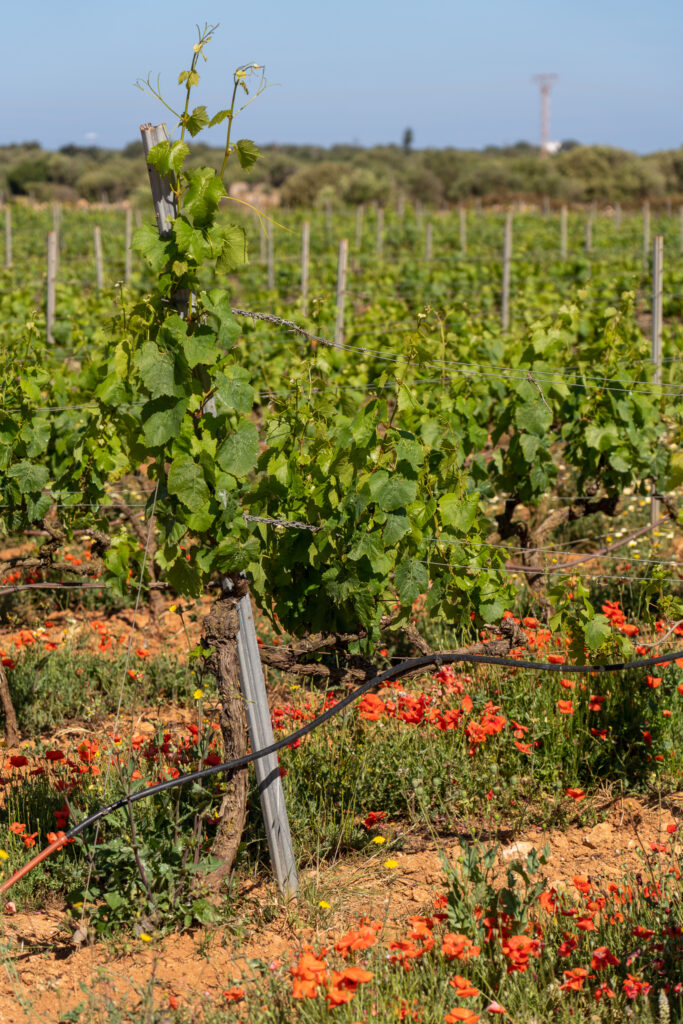
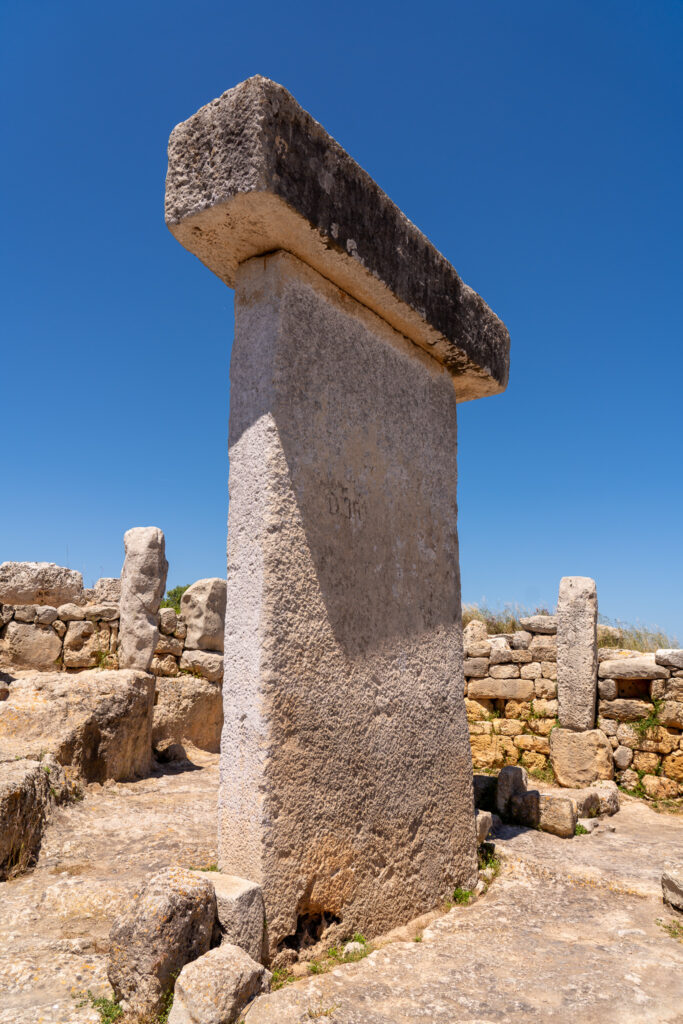
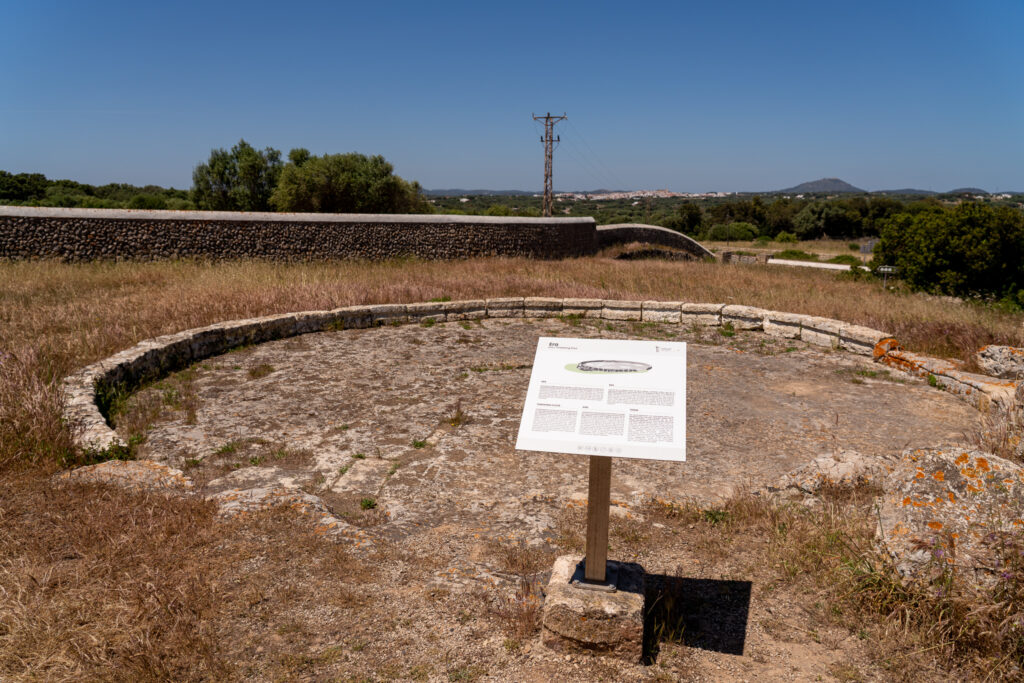
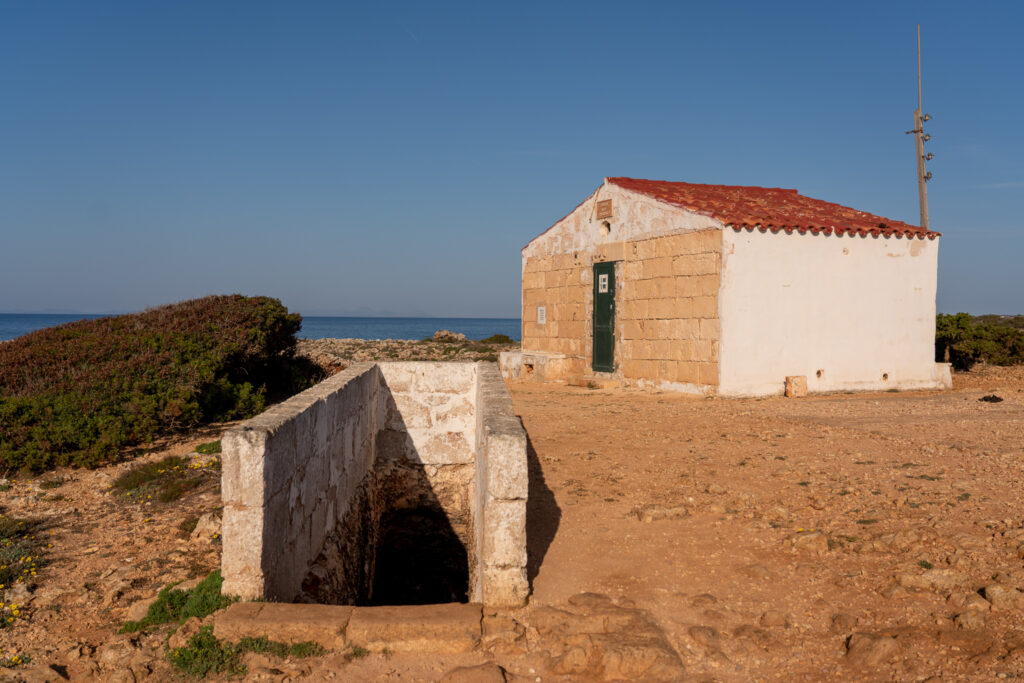
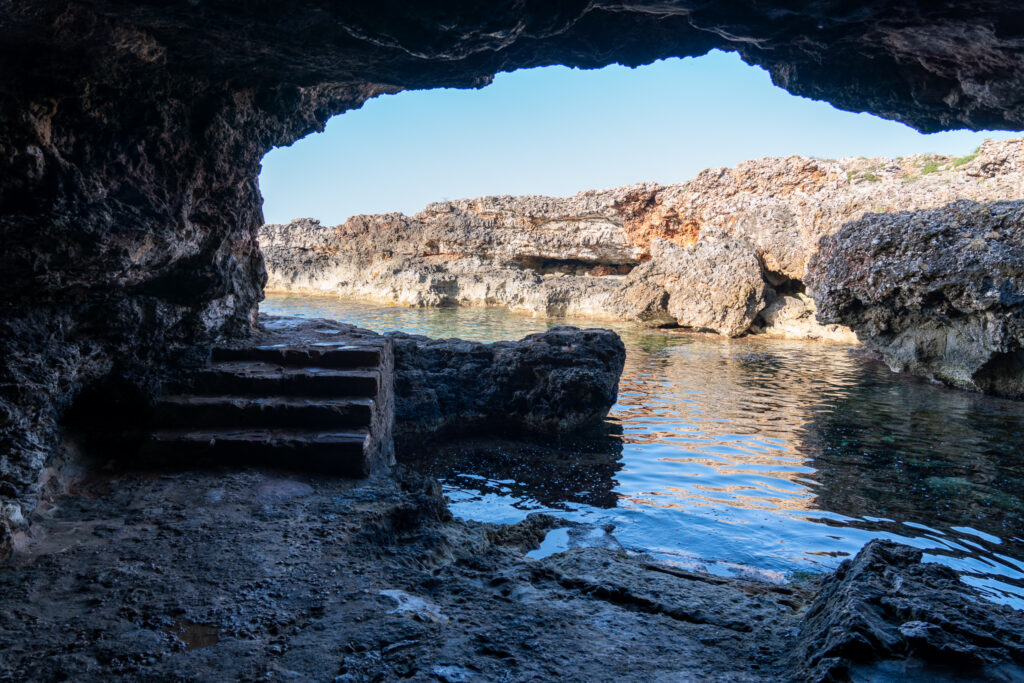
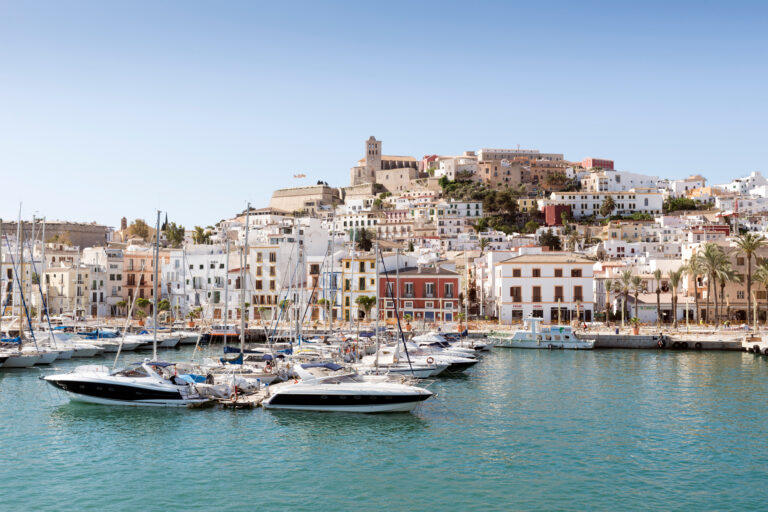
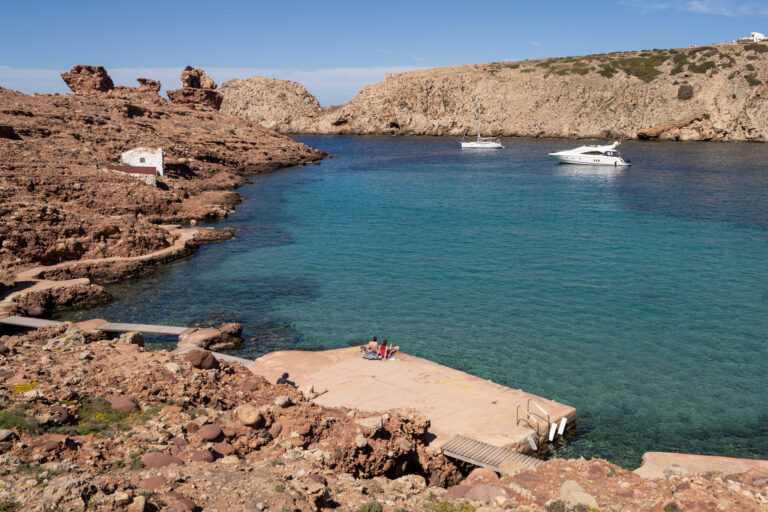
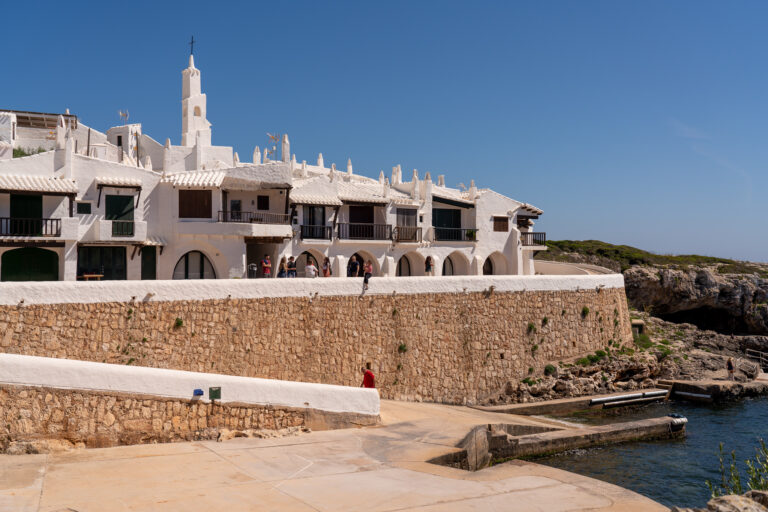
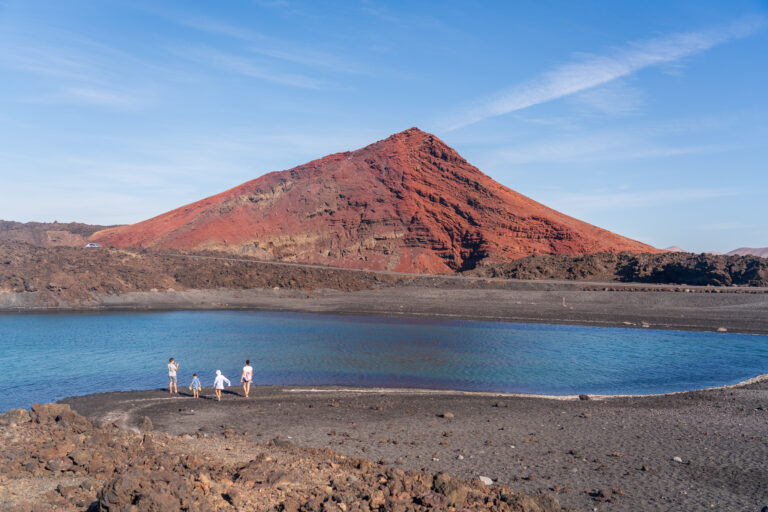
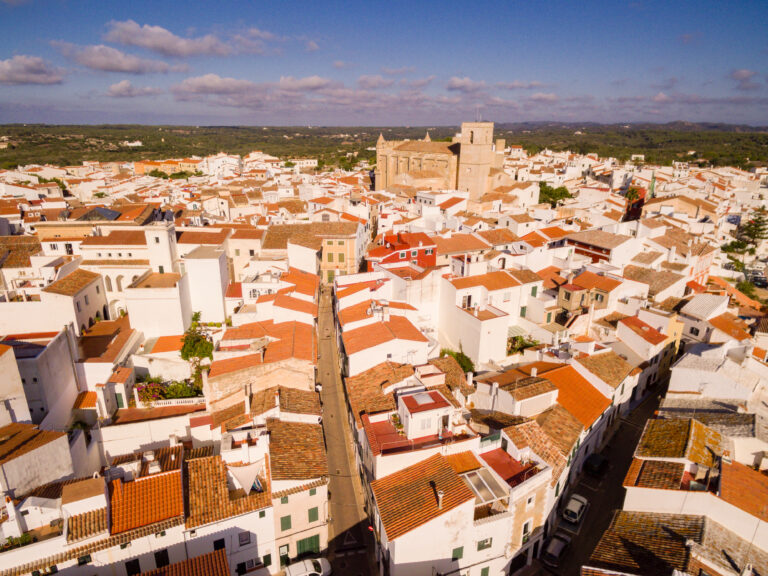
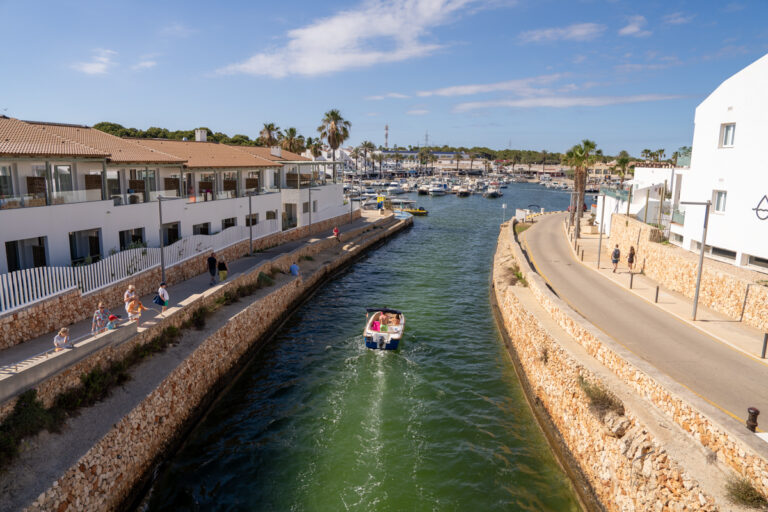
very interesting information on the island of Menorca which I visited over 60 years ago and I like the mentioned place very much. I am Welsh born in Wales so I am British By birth what I found interesting was the Hereford cows brought over by the British occupants also the Frisian cows and also the victorian style houses in Menorca